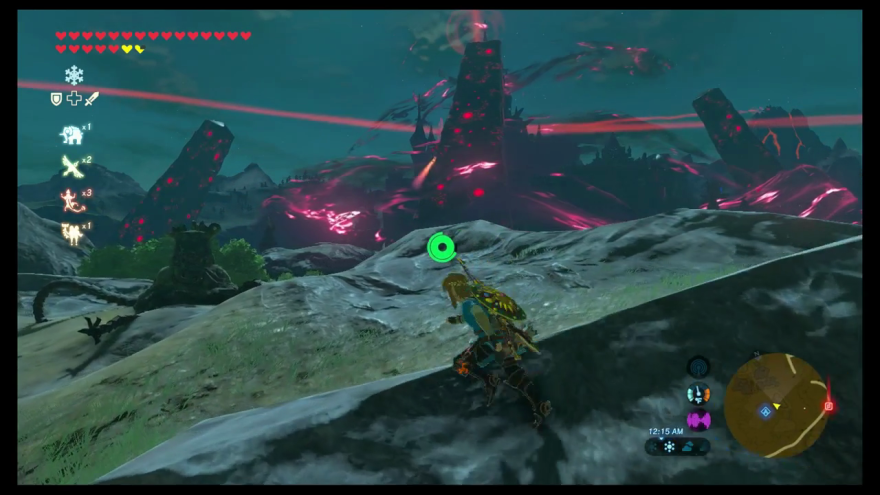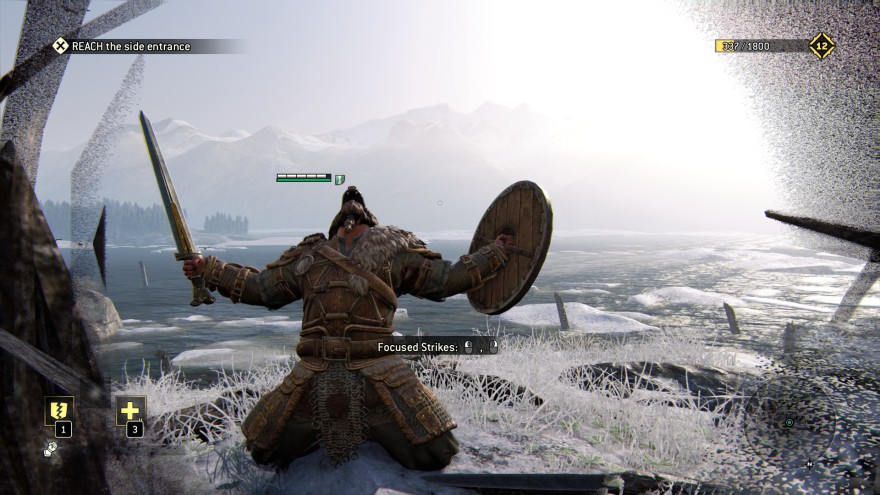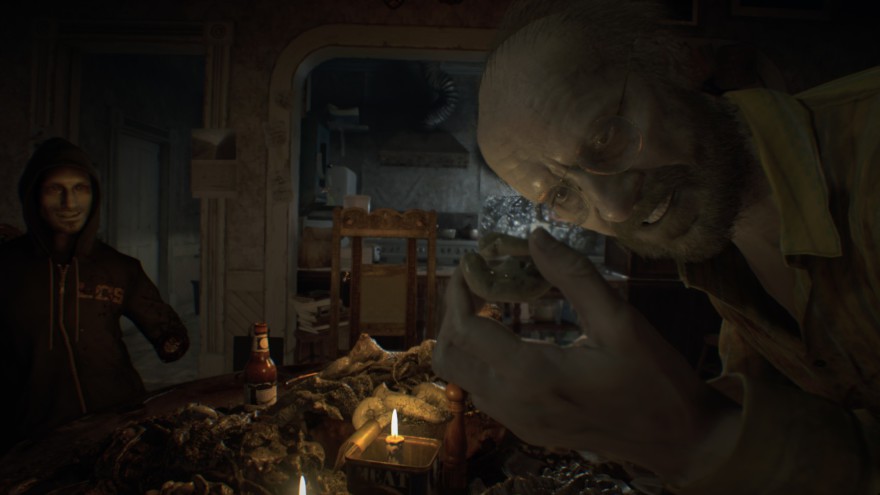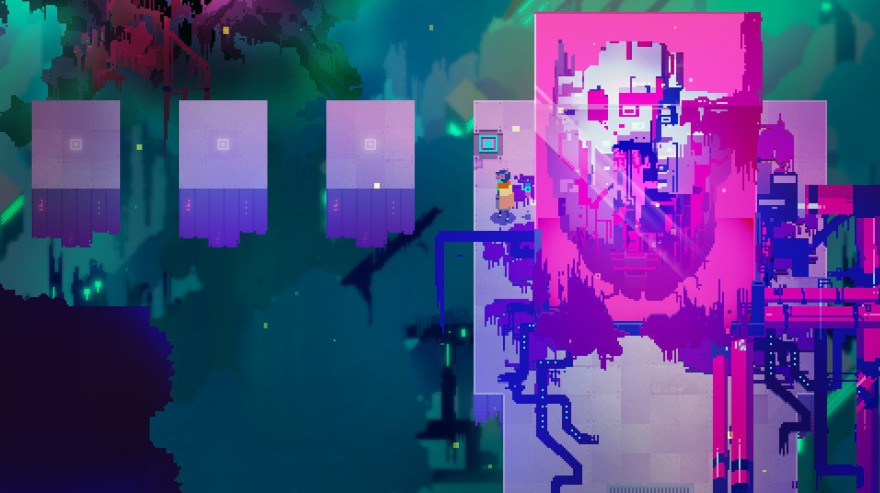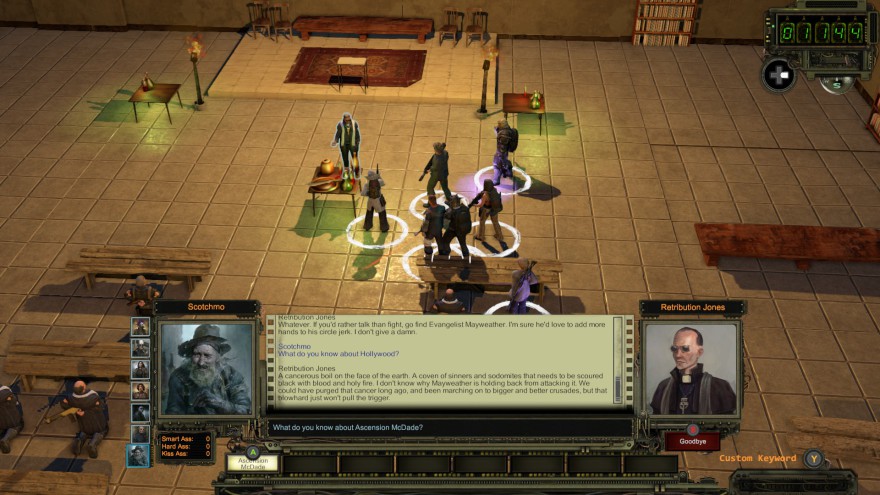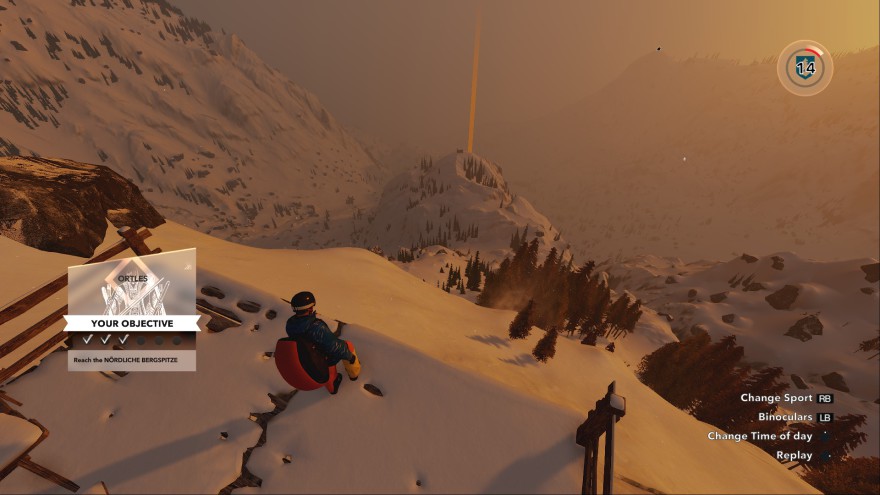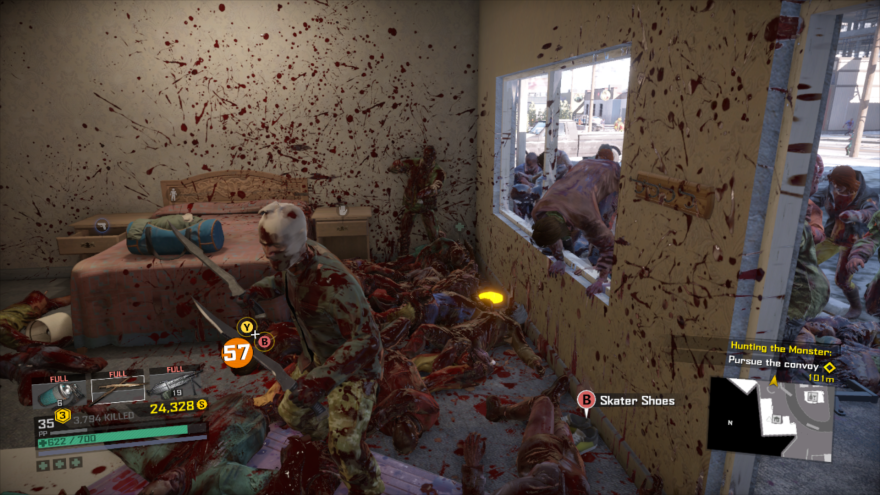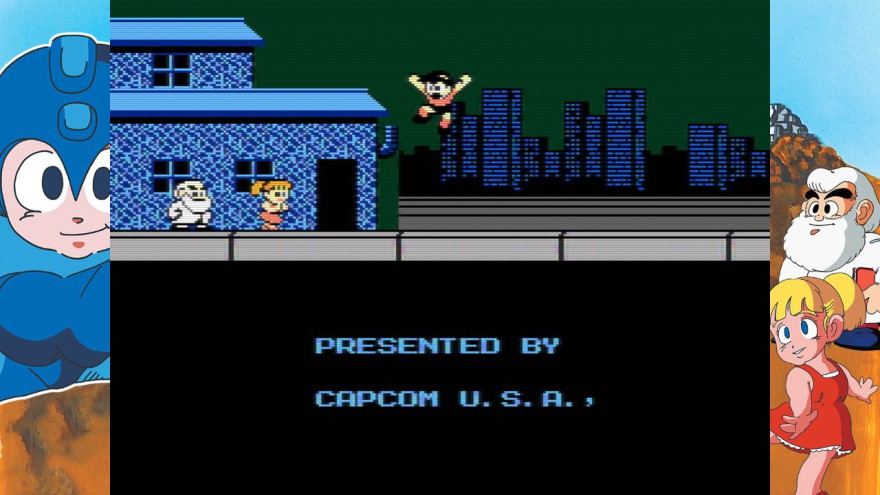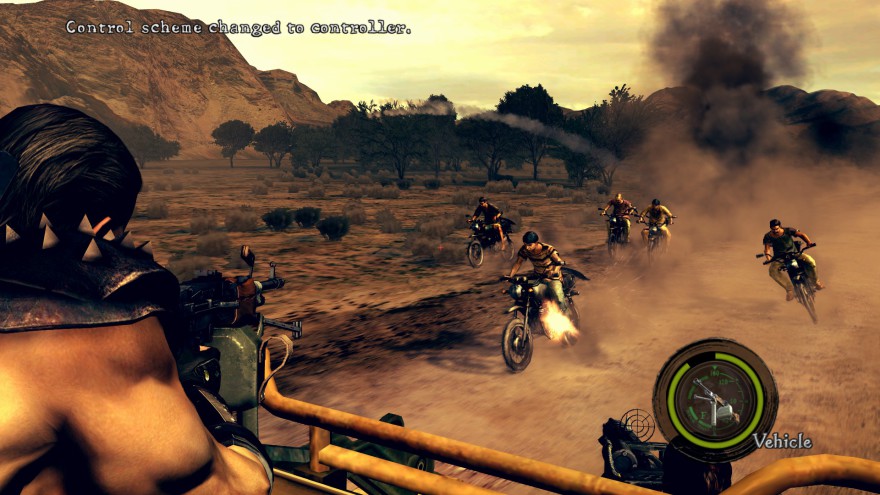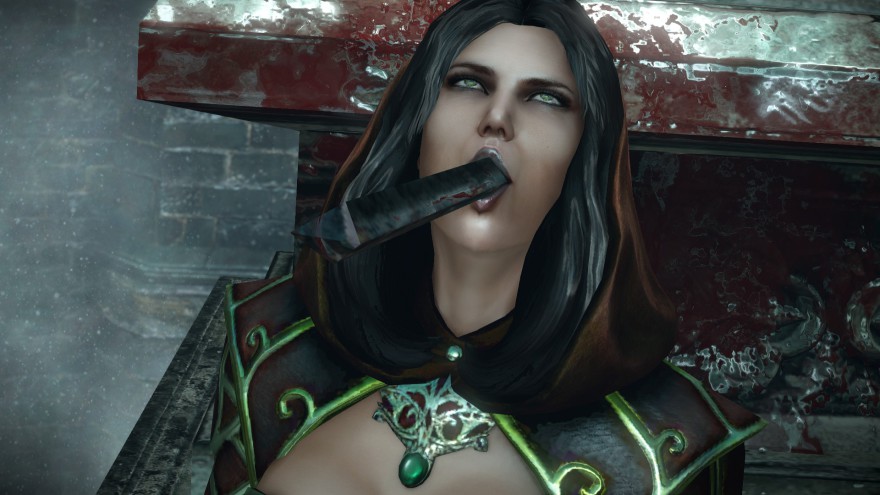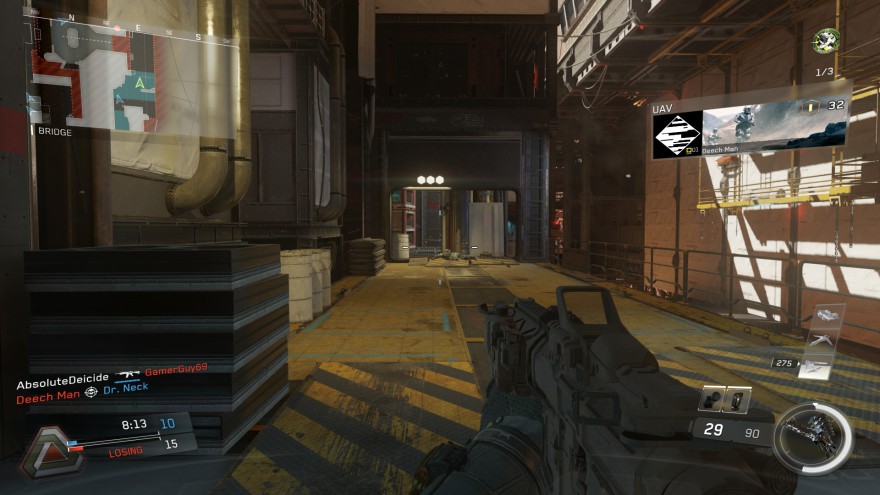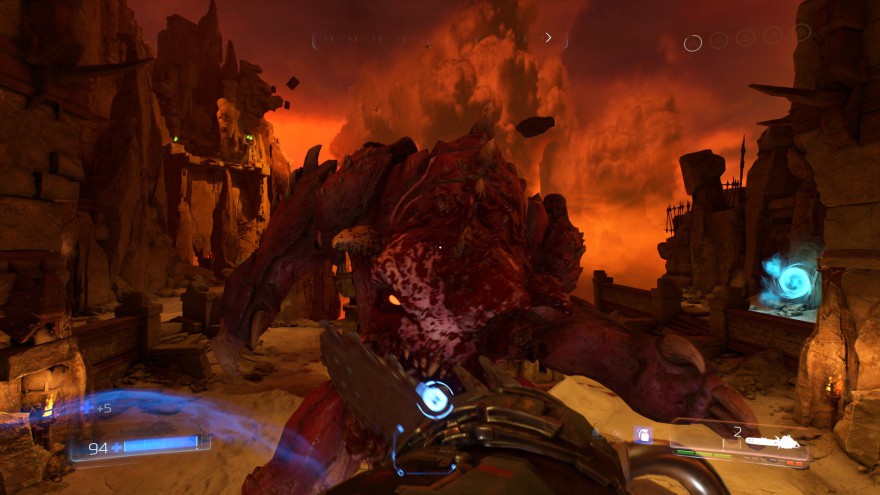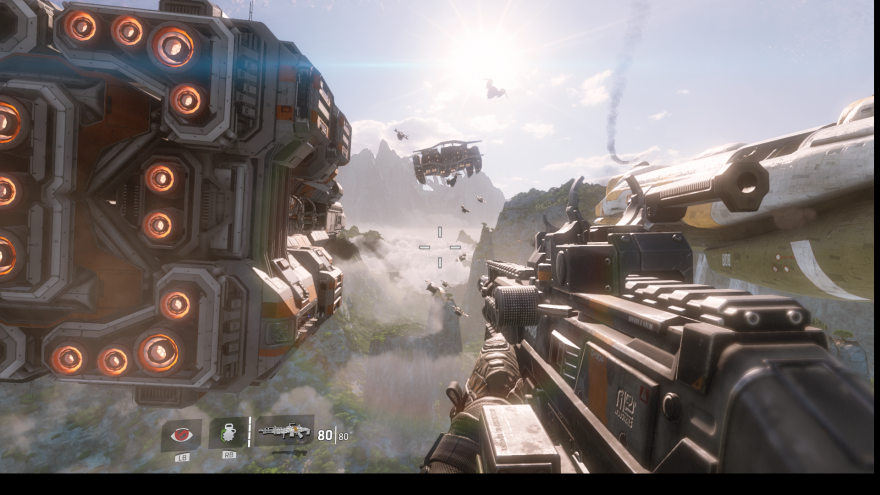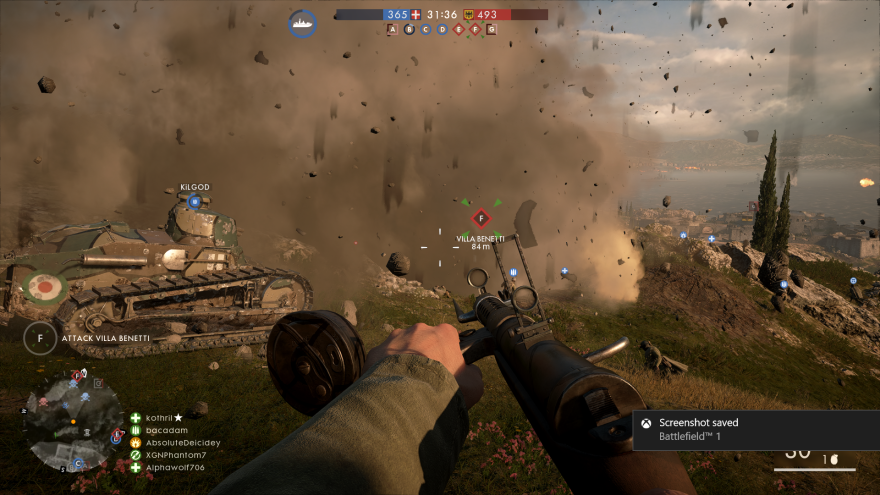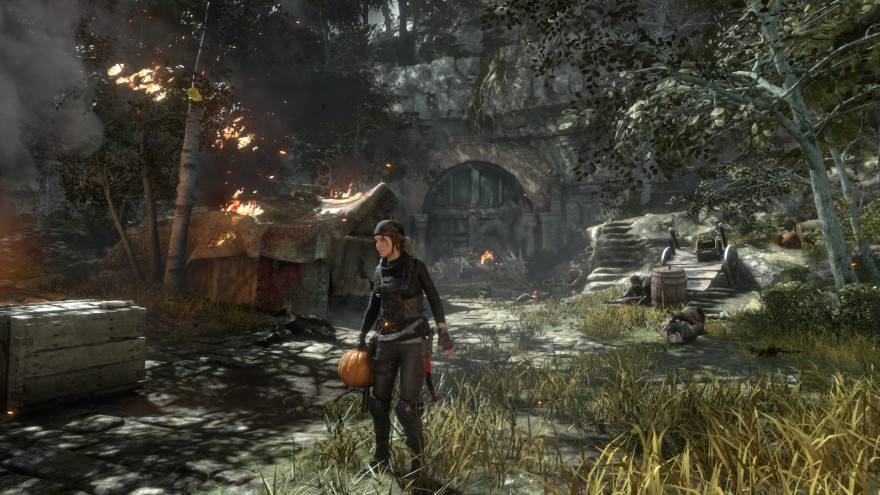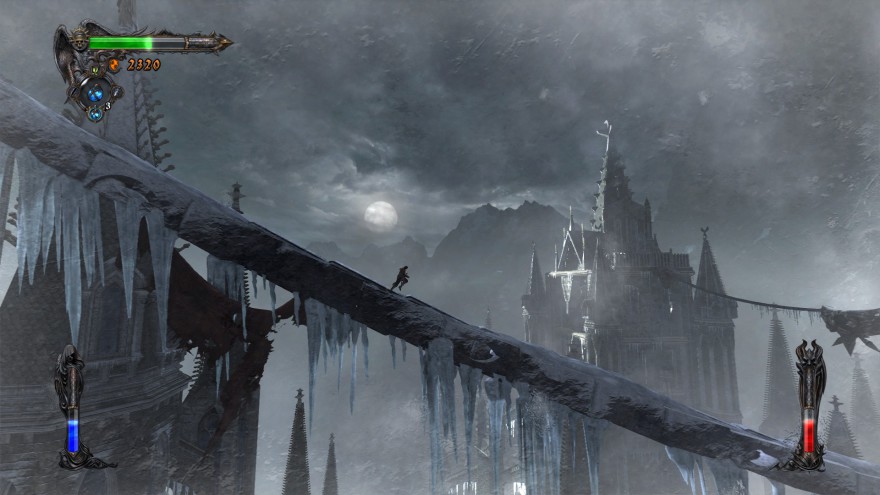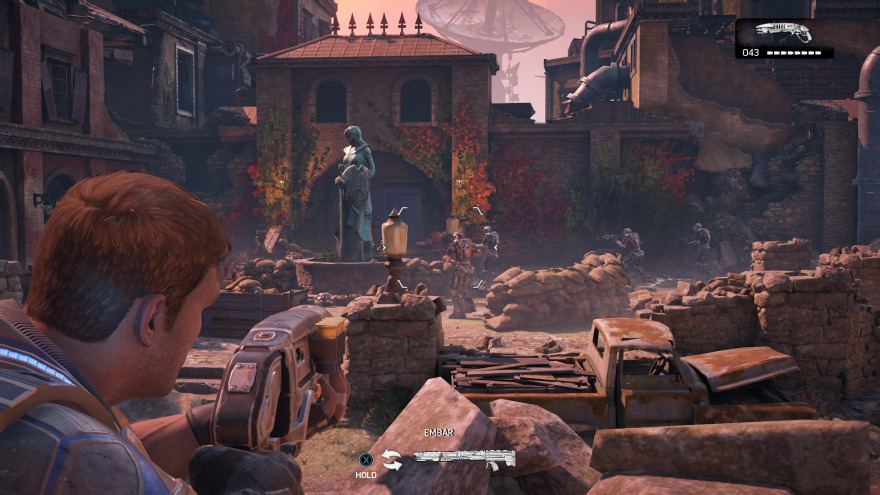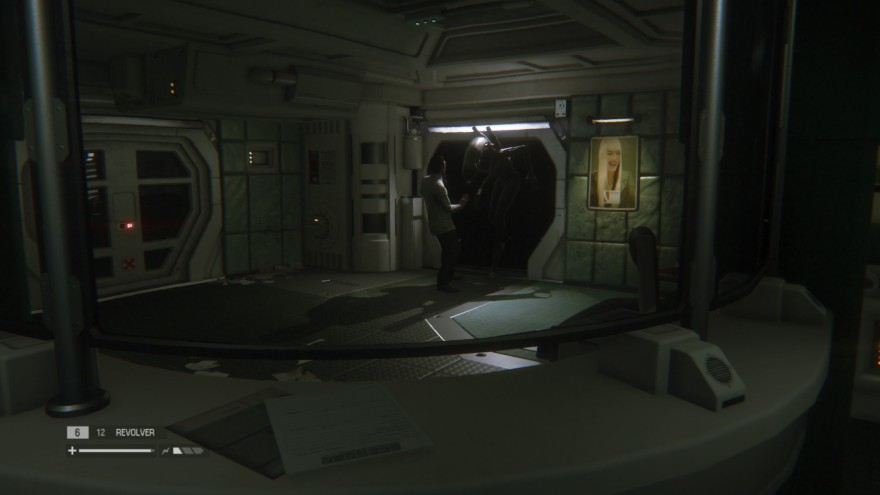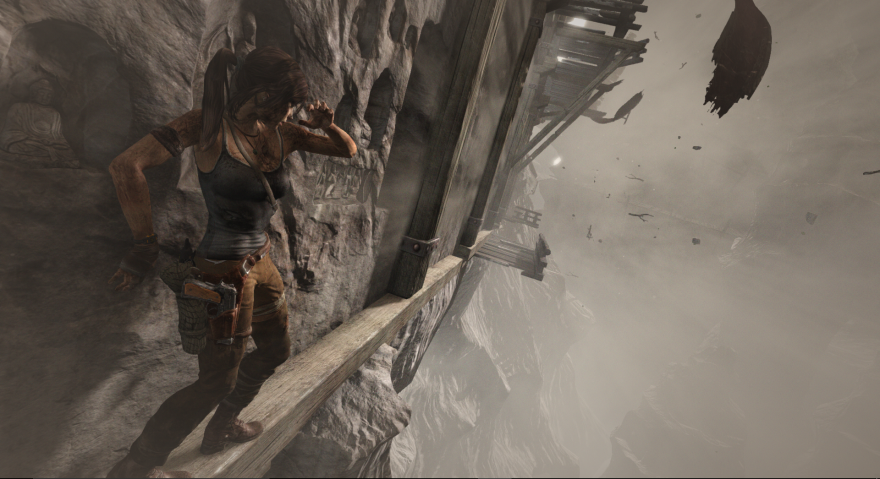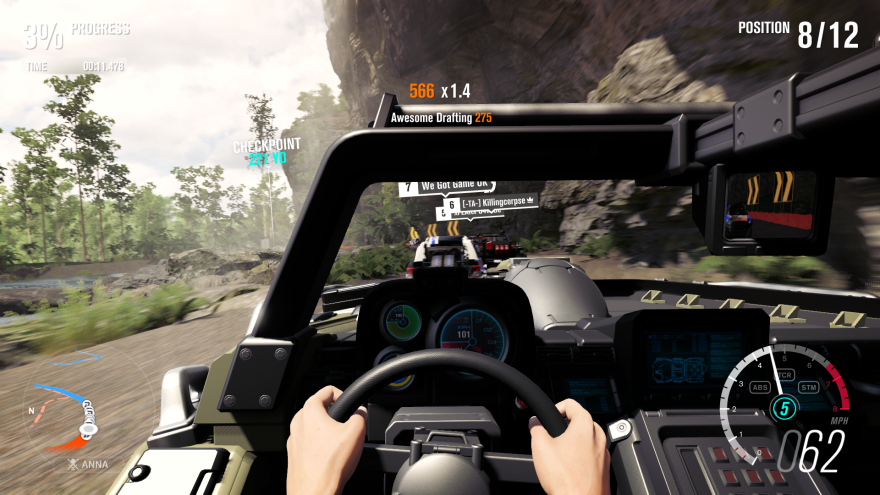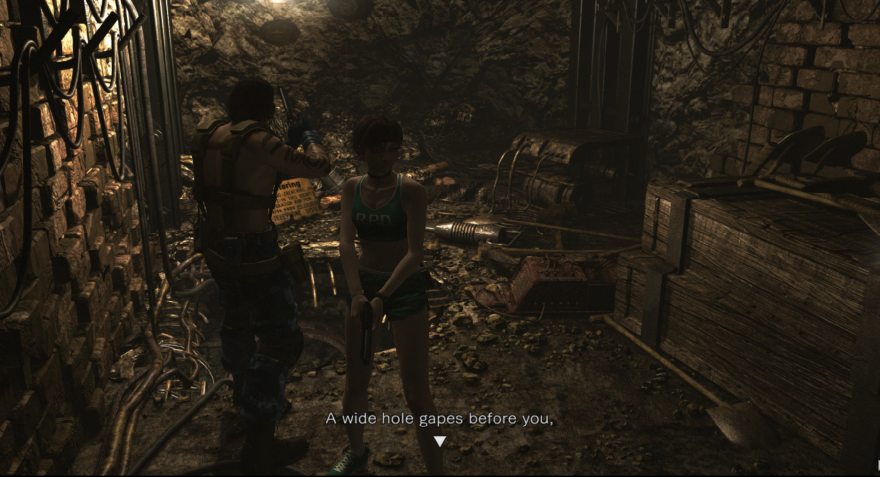A Random Assortment of Past Digressions...
The Legend of Zelda: Breath of the Wild Review (Wii U)
The opening moments of The Legend of Zelda: Breath of the Wild seem eerily familiar... The game's hero, Link, finds himself awakening from a century long stasis, rising from a stone sarcophagus. He's in a dark cave, amnesia stricken, and half naked. You explore the small space, tinkering with the controls, getting your bearings, then you approach the door to the vault/prison/pod. As blinding light pours in from the mysterious outside world you tentatively take a few steps forward, drawn to a conspicuous outcropping that will grant the perfect view of the vast, wide open landscape that begs to be explored. This establishing shot (as seen in any number of previous open world games) is meant to instill awe, wonder, beauty, danger, possibilities... but your first thought is, “Man, this game looks like shit.”
And Breath of the Wild does look awful compared to contemporary games. Fidelity-wise, anyway. It has a “unique art style” to put it in more generous terms. The graphics are fuzzy and lack detail on first inspection, and the cartoon look seems to mask an otherwise ugly game. Once you get moving, however, and your eyes adjust to the abandonment of sharp textures and any semblance of realism, it really does ooze charm. It's a throwback to classic animation of yesteryear; a combination of Disney cartoon and anime with a rotoscoped look. After the necessary eye adjustment, little details stand out; individual blades of grass bending in the wind, horses that gallop convincingly and are aware of your sound and smell, thunderclouds rolling in on the horizon, Link's shivering and visible breath in cold environments... the shock of Wii U fuzziness fades and an appreciation of VHS-era cartoons comes forward.
Structurally, the game seems cut from the same cloth as any other open world game as well: climb towers to reveal portions of the map, visit towns and talk to NPCs for side quests in order to gain advantages to make the main quest easier, collect flowers and junk to turn into items, etc. The difference and the charm here is a unique mixture of falling back on classic Zelda mythology (music, story, visuals), abstract systems ala Dark Souls, and a few strong, original additions that solve age old problems in video games in general.
Link can climb just about any surface like a spider monkey. Barring specific puzzle areas that are designed with certain solutions in mind, if you're in the overworld you can literally go wherever you want. Sheer mountain cliffs are not a problem as long as you have enough stamina or stock up on potion/foods to replenish your meter, trees, rocks, any geometry, really... “If you see it, you can go there” isn't just marketing speak in Breath of the Wild. This standout ability more or less completely destroys the restriction of invisible walls that plague many games. Every surface in the game is a play space, adding to the sense of freedom you have in the environment. It's one of those systems that makes instant sense once you try it, and will be sorely missed in any similar games afterward.
When the game embraces it's openness, it shines. Interactivity is above and beyond what you'd expect, embracing it's physics engine over canned encounters and solutions. If you see a tree on top of a hill and are feeling playful, you have options. You can climb around it, collecting apples to cook into a health-boosting meal later. Or you can climb to the top to get a better vantage point. If you want to chop it down you can do that, too... but you'll need a bladed weapon (an axe works best) and be mindful of where you chop to get the tree to fall the way you want it. Once it's felled, you can move it around, roll it down a hill to take out enemies, set it on fire, chop it up further to turn it into usable wood Minecraft style, roll it over a river to form a makeshift bridge... it's a toy in the sandbox.
And the sandbox feels hand sculpted by a singular mind. Ditching the realism allows for old school, deliberate game design, where a rock that looks out of place is probably meant to look out of place. Secrets and collectibles nicely fill out the map, forgoing the “walk to the next icon” loop most games in the genre fall prey to. There are small dungeons called shrines dotted around Hyrule, which act as mini-dungeons, fast travel points, and the main means to upgrade Link's health and stamina capacity. The game gives you all the tools you need to complete any and all of these very early on; a magnet to manipulate metal objects, a freeze tool to create ice blocks on water, two kinds of remote detonated bombs, and a stasis ability to lock objects in place. Gone are the longer, more elaborate trials from previous Zelda games, replaced with these bite sized tests. They usually take five to ten minutes to complete, depending on your observational and reasoning skills, and you're rewarded with an orb for your troubles. Collect four orbs, trade them in for either a heart (life) or stamina container and you're “leveled up” and ready to find more shines in more hazardous parts of the world.
The world will kill you if you're not prepared. Weather plays a large role in Breath of the Wild; you'll freeze or burn to death in extreme conditions without the proper attire equipped or ingesting potions/meals to combat the effects. Enemies will murder you in quick fashion most of the time, often in one or two hits for the majority of your play time. Armor can be purchased and upgraded to ward off certain elements, but survival is an almost constant struggle. The combat itself isn't great, either; weapons break at an insane rate, you'll often have no clue how you even died because an arrow flew at you from off screen or some random bullshit, and swinging swords/shooting arrows/blocking/parrying... it just doesn't feel particularly good. It's sloppy and frustrating, and even after forty or fifty hours of playing it never clicked into something enjoyable. I just said, “Fuck it” and ran past encounters whenever possible.
The story and main quest in Breath of the Wild is exactly what you expect from a Zelda game: you're the chosen hero, you must visit towns inhabited by different races to regain your strength to ultimately take on Gannon. It's classic, nothing wrong with it, nothing to shake it up too drastically save for the structure. In order to fully flesh out Link's past you seek out “memories” that are dotted around the map. Find these to trigger cutscenes that look great and allow the art to shine, but man the voice acting is cringe-y. Also, because you're solving shrines the whole way through, the main dungeons are a bit underwhelming. You need to board four giant, mechanical beasts Shadow of the Colossus-style. Once inside a new mechanic is introduced where you can manipulate parts of the beasts from your map, and you use that to solve puzzles and access out of reach terminals needed to take control of the beasts. These “dungeons” are as spacious and complex as the game ever gets, but they're a far cry from previous Zelda temples. The first one you attempt may be disorienting as the entire structure shifts, but once you get a handle on that one added element you'll most likely breeze through the remaining three. It's not a bad change, just after spending hours with your five tools then figuring out these main challenges, it's like someone took the standard, expansive Zelda dungeons/temples, broke them apart and scattered them to the wind. Still fun to play, but the climax and length of the setpieces take a hit. Even the final battle with Gannon, which I was hoping would be an epic, lengthy reward for hours and hours playing this giant game... fifteen minutes or so and it was over. It looked phenomenal, but it lacked any kind of puzzle element or reward that felt fitting to the style of the game. Oh well, “the journey is it's own reward” or some hacky bullshit...
Breath of the Wild is true next generation Zelda. While that means (in Nintendo terms) it's still playing catch up in some areas, building off of other successful open world games that came before it, the game still retains that elusive Zelda magic. Plenty of other games have borrowed so many elements from the series that it's fitting for things to now come full circle. The climbing mechanic and sense of freedom sets a new bar for the genre. Certain aspects can be downright irritating, but taken as an experience it will suck you into Hyrule and you'll willingly get lost. In the woods. The Lost Woods. It's Zelda.
For Honor Review (PC)
Modern video games are often very predictable. As the medium matures, there are few surprises and fewer innovations to experience. Graphics haven't seen a big leap since 3-D polygons hit the scene, the visual fidelity of the games are improving at a steady clip, controllers are more or less standardized, genres are over saturated to the point they're borrowing from each other to create something even more homogeneous, we've been sold “innovation” countless times that usually pans out to be half assed gimmicks, we turn to “independent” games for changes of pace that recycle old ideas and pass that off to smug hipsters as rebellion against the static mainstream. To look at For Honor without putting your hands on it, there's nothing particularly new there. A medieval setting, melee combat, Mortal Kombat-esque fatalities... big deal, right? Even after a few matches you might be tempted to dismiss it as shallow button mashing and nothing more. Once you grasp just how innovative and elegant the control scheme is, and the amount of depth and strategy the brutal combat allows you start to see the genius in it's simplicity and the long road to mastery. For Honor is it's own beast, and it's angry and hungry.
The attraction to the game is entirely mechanics driven, which is of course the hardest and least sexy bullet point of a game to describe. The first layer of combat is using the analogue stick to decide where to hold your weapon: to the left, right, or overhead. This is the both the direction your character will strike from and where he/she will block any incoming attacks. At this basic level you're playing rock, paper, scissors: a quick shift in direction to attack a slower opponent can score a clean hit. You can perform a quick attack or a slower, more damaging heavy hit if you have the opening. Simple, right? Not when you add in a throw button, which will at a basic level break your opponent's guard and leave them defenseless for a free smack. So turtling, playing defensively isn't going to save you for long: the game wants you to attack, but not recklessly or you'll deplete your stamina bar. Once you land a hit you're going to try to chain some combos to take advantage of the enemy's mistake, and those are character and timing dependent; some are unblockable, some end up dazing the poor bastard on the receiving end, and some will apply poison... Not so simple now, is it?
You could call For Honor a third person, over the shoulder fighting game and not be too far off. Once you lock on to someone and you're going mano-a-mano, the basic concepts of the traditionally 2-D genre apply: footsies, headgames, multi-hit combos, etc. Another staple is the need to master the cast of characters and how they match up against each other. There are twelve warriors to choose from, each with vastly different stats, abilities, weapons, and movesets. They're not exactly brimming with personality, but they look badass and trying to play to each of their strengths is a commitment. They range from quick and agile harassers, massive but slow damage dealers, berserkers that should rush into battle, and trickier long range spear wielders. All of them are fine to pick up and play and their stats and roles seem balanced, with no one or two characters standing out as “top tier” or cheap. You can open a moves list to show their special combos and abilities, but figuring out the situational uses and timing of those is going to take practice. “A moment to grasp, a lifetime to master” is a fitting cliché.
Know that the online multiplayer modes are the bread and butter of For Honor. There is a fully fleshed out eight hour campaign, but consider that training before you take the game online. That's not to say the single player is bad in any sense of the word: some serious production value went into the faction/globe spanning levels. The game looks fantastic in general, even more so in the single player setpieces that depict near Braveheart-scope war and skirmishes atop ice flows or rivers of lava. The motion capture and voice acting is well above average, and the premise of some alternate history weirdness where Vikings do battle with Samurai and Knights is acceptably ridiculous. The story itself is Games of Thrones inspired fantasy minus the dragons, where life is all but worthless and some badass broad is trying to unite three culturally different clans. It checks all the boxes for “fantasy story”, but something about it still feels soulless. The constant character switching is great for introductions to the classes, but doesn't do any favors for you giving a shit about any of them. Again, not bad, but not memorable. I'd suggest playing it, though, if just for that training and to earn enough currency to unlock all of the multiplayer characters straight away.
Once you get into the multiplayer like you should, there are enough options and currencies and choices to confuse the shit out of you. You're first asked to pick one of the three factions, but that won't lock you out of any of the characters, it's just relevant to the ongoing Faction War metagame. After every match you play you're given “War Assets”, which is basically a point value based on your performance you can place on a Risk-like map, pushing your factions front in a season based war. That has nothing to do with the actual gameplay. You can choose from a one on one Duel, two on two Skirmish, or the main four on four mode: Dominion. The other options are Deathmatch and Team Deathmatch, and Dominion is Domination with a couple twists: the first team to reach 1000 points wins, but capturing territories subtracts from the enemy team's score to allow for some back and forth comebacks. There's also a neutral point on each map where AI from both teams clash, and you have to clear all of the hostile, one hit grunts out of the way before you can claim that point. Dominion games are often delightfully messy; turning into a mosh pit where you're more likely to get clocked from behind than have an honorable one on one fight. It's metal as fuck.
After each match you're awarded XP for the character you picked, and he or she will level up and unlock perks and abilities. Balance is still key, so you can only have four perks equipped at a time; some are passive boosts, some need to be earned by good performance during the game and activated manually. There's always a trade off. You also have a chance to find loot after each match, which you can equip to change your stats or melt down into steel (or scrap or something) to upgrade other equipment. You have daily challenges to accomplish which will net bonus coins and XP, and there's a store to buy boosts and cosmetic effects... yeah, all that shit is a bit much for me, but there's plenty of depth and customization and it all seems balanced. The networking is great for the most part, bar some oddities with parties being disbanded after lobbies empty out and some synchronization pauses if anyone leaves a match. But the vast majority of the time it's solid.
If you've ever wanted to bash someone's brains in with a pike, check out For Honor. It uses a standard controller in unique ways to deliver the best brand of melee combat out there. Don't be fooled by the simplicity of what you see on the screen or scared away by the seeming lack of game modes; there's plenty of depth and a massive skill gap to conquer. If you're complaining about lack of innovation in big budget games and pass this gem up... go fuck yourself you hipster piece of shit.
Resident Evil 7: Biohazard Review (PC)
Resident Evil 7 is a game of references. From the opening shot that is lifted almost directly from The Shining to the last minute cameo by a familiar face of the long running franchise, playing “spot the influence” is an ongoing metagame throughout the entire ten hour long campaign. It's hard to categorize the game as an honest sequel to the storied series; any ties to the established characters or lore are tangential at best and are almost hidden Easter eggs for hardcore fans to dig up. Instead, Resident Evil 7 acts as a greatest hits album of the horror genre in general, and completely abandons any convoluted baggage acquired from over twenty years of fan service in favor of safely bringing the series into the modern horror game landscape. It's not particularly original. It doesn't move the genre forward any great lengths. But it's a damn good first person survival horror game.
I've been waiting for a sequel to Condemned 2: Bloodshot for almost a decade, and Resident Evil 7 may as well be that game. The protagonist is even named “Ethan”... Played entirely from a first person perspective, you spend most of your time rummaging through trash and filth, battling goo monsters and psychopaths in dilapidated environments and searching for supplies to fend off the creepies. Your mission is to rescue your girlfriend from the clutches of an unhinged, cannibalistic, superhuman family that branched off the Texas Chainsaw Massacre genetic tree. Each family member acts as a gatekeeping boss and their personality traits dictate the hazards you'll face in each “level”; the father is a physical damage sponge, the mother is a supernatural stalker, the son likes to play games and set traps like Saw's Jigsaw, and the grandmother is a mental mindfucker. You'll dispatch each of them and solve simple puzzles to unlock wings of the Cajun mansion and some of the surrounding bayou, but the game remains intimate and small scale throughout.
Graphically, Resident Evil 7 is extremely impressive in it's depiction of rot and decay. Even when things get surreal and supernatural, with black slime undulating on the floor and walls and obese zombies projectile vomiting at you, there's a commitment to realism and polish that sells the setting. You can almost smell the rotting food in the cobwebbed refrigerators and being funneled into a realistically flooded basement elicits some real dread. There are filters and effects galore, including taking part in a few found footage style VHS mini-campaigns. Most of the horror comes from visceral gross out scenes, and it's only effective when this much attention to detail is payed to decapitated bodies and spider infested doorways. There's never really a pleasant moment to be had during your visit. The entire game can be played with a VR headset, though I wasn't able to try this (or wanted to, frankly). While I could see how the isolating nature of virtual reality could potentially add to the atmosphere, playing on a traditional television led to some cheesy situations; extended, gratuitous scenes of sharp objects being waved in your face or characters invading your personal space can reek of a tech demo. It's not overly distracting or a game breaker, but it's akin to watching a movie made with 3-D technology in mind on a 2-D set.
You enter the Baker mansion unarmed and vulnerable, but before long you're armed to the teeth with the expected arsenal; an always handy, box-breaking knife, a pistol, then a shotgun, a machine gun, remote detonated bombs, and the flamethrower from Alien: Isolation (you were warned about the references...). Ammo can be scarce and enemies take somewhat random amounts of damage before they go down for good. A single shotgun blast to the face of a standard enemy may blow his head off, or it may just bowl him over. The intentional clunkiness of the combat feeds into the Resident Evil mantra of deciding to spend either health or ammunition to get past a situation, and the save rooms and inventory management are critical to survival. The magic, bottomless inventory box returns from previous games, probably the most overt tie to the series' legacy. Combining herbs to produce healing items is also present, but the mechanics are more complex; instead of green herb plus red herb equals super healing item, you now use a chemical agent to mix with the herb and that same agent can be used in formulas to create handgun rounds or flamethrower fuel. Again, it's that health versus ammo balance. You have a limited number of items you can carry on your person, so there is some backtracking, experimentation, and fiddling involved. Toward the end of the game I was so stocked up on a half dozen types of weapons and items it became frustrating to manage, but again that's one of the most Resident Evil-y things about Resident Evil 7.
Resident Evil 7 is a celebration of all thing horror, which the series kind of was at it's roots, anyway. Part of me wants to... condemn the game for being Resident Evil in name and nebulous themes only, cashing in on the series' history, but I guess I'm not attached to the franchise enough to really care. It may not be the “scariest” horror game out there or the best example of first person story telling, but as a mass market, big budget spooky roller coaster ride it's quite impressive.
Hyper Light Drifter Review (PC)
At first glance, Hyper Light Drifter appears to be another pixel art, nostalgia fueled action/platformer that saturates the “indie” marketplace. After completing the game... yeah, that's pretty much what it is. Presented in the faux-retro, kind of 8-bit maybe 16 with way too many colors and digital audio we've come to know and accept, the good news is it's a good one of those.
Best described as a Zelda-like, after an ominous and perplexing cutscene you're thrown into an open world with little tutorial or direction. The controls are very basic: you can slash with your sword, dash, and shoot a gun. The game never gets more complicated than that, you can just purchase upgrades to strengthen those abilities (dash through/deflect projectiles, larger energy capacity for your guns, etc.). Exploring reveals four distinct paths you can take in each cardinal direction. Each path has a loose theme like desert or snow, and you can tackle them in order you choose. The goal is to thoroughly explore each area until you find four pink triangles and defeat the stage boss.
It's a simple, old school concept that expects you to be familiar with retro games. There is no text or dialogue at all, just the assumption that a store looks like store and an abstraction of an inventory menu is what you think it is. The minimalist presentation teases mystery and deeper meaning, but once you acclimate to the language everything is very straight forward. The same can be said for the story, told only through flashbacks and visual interactions with NPCs; it is what it is, and without even going into spoiler territory if you think of the cliché narrative of “artsy” games you know what you're getting.
Hyper Light Drifter is visually appealing. Simple yet detailed and colorful, it's a prime example of pixel art done right. Unfortunately, the viewpoint the game uses can make navigation a nightmare. From the three quarter perspective the environment can obscure your character and pathways. This makes for plenty of secrets, but searching for those secrets becomes tedious as you're all but required to hug every wall and object to suss out the play space. It can be a problem in combat as well when you get caught up on enemies and trapped. Even the critical path can come down to guesswork, and this isn't helped by the almost useless map. It looks like a mess of pixels at first, and after playing with it for hours and experimenting with how your position is conveyed it's still only reliable for general directions.
The combat can be fast and satisfying when you're warping around, using a combination of sword slashes and firearms, getting in and out of melee range to avoid attacks. It's a game of recognizing enemy behaviors and patterns, just as you'd expect from old school inspirations. Your firearm has a limited number of uses which can only be recharged by slashing foes, so you can't avoid close quarters for long. The boss fights are memorable, each having multiple behavior patterns and gimmicks that change once you whittle their health down to a certain point. It's equal parts challenging and cheap, as (once again) you'd expect.
Generic, expected, derivative... those are all adjectives I'd use to describe Hyper Light Drifter, but not really as a derogative. If you're in the market for another new wave “retro” experience, climb aboard. It's comfort food that's been prepared in it's own style.
Wasteland 2 Review (PC)
Wasteland 2 is Fallout 3 is there never was a Fallout 3. To clarify: the original Fallout was a “spiritual successor” to Wasteland, a party and turn based 1988 RPG. After Fallout 2 Interplay (the company with the rights to the Fallout series) folded, and before modern, Bethesda developed Fallout 3 was released there were various other games in the series being worked on but ultimately fell apart. Wasteland 2 exists in an alternate timeline where the Bethesda deal was never made, and the evolution of RPG game design also stopped after Fallout 2. It's a game that tugs on the nostalgia strings of classic CRPGs, and makes very few concessions to accepted quality of life improvements that are now standard features of video games in general. While I certainly appreciated the initial joys of the throwback, the dated and repetitious nature of playing through the lengthy campaign eventually wore on me and I couldn't help but feel like I've done this all before... multiple times.
Despite the convoluted history, Wasteland 2 is a direct sequel to the first Wasteland as far as story goes. You're brought up to speed via a pretty slick live action video detailing the aftermath of a nuclear apocalypse. In Arizona, a group of order-loving Desert Rangers set up a base inside a prison, the released prisoners became roaming gang members and cannibals, mutated creatures and robots threaten the burgeoning communities, the Rangers battled an AI threat, and now they are set up in a new base and are back to their peace keeping duties.
You can create a custom party of four player characters, setting their stats, bios, and avatars, or just take a default, premade group. I took the default group, because going in blind, trying to make sense of attribute points and the dozens of skills available is a nightmare, and you'll quickly find out the game can and will screw you over with curve balls you have no control over and old school beginner's traps. Again... some may revel in the “difficulty” of min/maxing character stats, but I found many instances where I was perplexed at how a modern game could repeat the pitfalls of the past. While journeying through the wastes you'll also run into NPCs that are willing to join up with your group, upping your party count to seven. Your crew doesn't have much in the way of personality; aside from a few shout outs or unique interactions, they are basically defined by their stat spread. With so many available stats, you're forced to have each character specialize in one or two disciplines, so they devolve into “medic”, “sniper”, “tank”, etc. They are basically board game pieces rather than characters.
Your journey to expose and confront new threats to the Ranger's brand of law and order is a lengthy one, though the story isn't particularly compelling. The loop goes: enter a town, talk to the town's leadership to uncover said town's problems, fight bad guys, move on to the next town. That may sound overly reductive and could apply to most RPGs, but by the third or fourth town you've saved the strings are laid bare. Then the game continues for about twice as long as the story or mechanics are capable of holding it up. Wasteland 2 is a lower budget game, which is fine, but certain areas feel unfinished/unpolished. The quality of the voice acting is all over the place, sometimes just cutting out halfway through a character's dialogue. Avatars and sprites are used repeatedly, making it a chore to remember who is who in cities full of clones. There is a hard cut to a second act, with the dramatic shift told through text and still artwork. Again... old school? Sure. Acceptable in a modern video game? Ehhhh...
Most of the game is focused on combat. You battle mutated animals, gangs, and robots in traditional, tactical turn based battles. Cover is key, granting bonuses to both your chances of evading incoming fire and hitting your shots. Flanking and prioritizing your targets can mean the difference between a quick victory or your entire team falling apart, in which case you can practice the age old ritual of save scumming... Another blast from the past: there is no option to rest between battles. If you take damage, you better have a medpack handy to heal, otherwise it's going to be a long trek back to Ranger Citadel. Actually, it's going to be time consuming anyway, because any time you use Healing, or ANY skill (which you'll do hundreds if not thousands of times) you're forced to watch a five second animation play out as a progress bar fills up. Why the waste of time to see the results of a die roll? Nostalgia? And if the roll fails, well... save scumming again. Because nostalgia. Or poor game design.
As much as I love old CRPGs, they are old games that have been improved upon. I really wanted to like Wasteland 2 (and it's not a horrible game), but it felt like work more often than fun. It can't quite figure out how to fix old problems with party based games, like when a companion NPC up and decides, “I must go now because story reasons” and leaves you with a giant hole in your squad. That happened three times... After playing for about sixty hours, I was still holding out hope for a grand payoff either from the plot or mechanically, but it never comes. Instead the micromanagement and tedium took it's toll.
Steep Review (PC)
Steep is a weird game. A love letter to exploring the picturesque Swiss Alps by way of extreme sports, it toes the line between realism and Red Bull guzzling, MTV goofiness. It's built for scale and spectacle, but digging deeper to actually play the game can feel like you're on a team of beta testers, sharing challenges you pulled out of your ass and turning a blind eye to the glaring glitches and rough edges. It suffers from an identity crisis; one minute you'll be paragliding peacefully above a glacier while your avatar narrates a somber diary of conquering the wilderness, fighting oxygen deprivation and dehydration. Then you'll be following a literal ghost rider through the mouths of Ubisoft's Raving Rabbids mascots or being lectured by a stereotypical New York agent for not hitting enough “sick” kickflips. Or a mountain will try to intimidate you, reciting some Robert Frost style poetry. Steep is best played with an open mind. A really open mind...
The game can be stunningly gorgeous; the scale of the mountain range is very impressive and boasts some of the most realistic looking representation of snow I've seen. The glittering of the sun off of fresh powder in particular is approaching levels of photorealism. The detail of your character is quite sharp as well, especially considering the vast amount of unlockable accessories available to outfit him/her in. Traversing the frozen environment also leaves convincing tracks as you sink into the drifts, climbing steep slopes to reach points of interest. An applaudable amount of work and artistry went into the snow, but some of the elements surrounding it look out of place. Rocky surfaces can look like smears painted with a broad brush, often visibly, hastily thrown together at artificially rough angles and clipping through each other. Trees and glaciers are carbon copies of each other, leading to stretches of boring, repeating terrain. But the large scale picture is the reason for playing, and these are the compromises of a completely open, load-free playground.
You have five modes of transport at your disposal: skiing, snowboarding, paragliding, wing gliding, and walking. Skiing and snowboarding are similar and the challenges that feature them are interchangeable. You have very simple controls with these two: steer with the left stick, the right stick cuts sharply, you hold and release jump to ollie, and from there you can spin and grab. For the most part, though, you're at the mercy of the mountain; it's incredibly difficult to make quick adjustments and it can be a struggle to get your avatar to do what you want to do without serious effort. You have no control over the camera, and that becomes an adversary; jamming to the right trying to hit a checkpoint can easily be undermined by a wild, uncontrollable swing or zoom because the game felt like it. You certainly don't have Tony Hawk/SSX levels of control, which is fine, but what's in Steep is better described as “loose” than simulation. After about twenty hours of playing I felt adjusted to the game's quirks, but more often than not trying to get your rider to generally perform something specific still comes down to trial and error, combating the controls, and a good amount of luck. You're provided with a G-meter that is supposed to track how much punishment you can take before you spill, but in practice the game just does what it wants; a ten second free fall onto solid rock might be okay, but hitting what appears to be a pebble may or may not send you into a knockout faceplant.
Wing gliding is the highlight. Flying inches above the ground, weaving around snow covered trees and sharp rocks is exhilarating and it controls responsively. Most of the challenges in the wing suit revolve around passing through rings and gives a serious Pilotwings vibe. Paragliding is more relaxed and is the preferred method for exploring the Alps, allowing you to cover large swaths of land and soak in the sights while you're at it. You're given a very generous updraft system: get close and kinda/sorta perpendicular to a mountainside and there will always be uplift, essentially allowing you to glide endlessly. I'm pretty sure that's not how wind works, but whatever. Walking is where you put one foot in front of the other to initiate locomotion, and while on foot you can use binoculars to spot drop zones and places of interest.
The scale and freeform exploration is great, but the “game” part of the game, the challenges, are all over the place. These events are scattered all over the mountains and they generally races against the clock or score based affairs. They are categorized into Easy, Medium, and Hard difficulties, and you can earn bronze, silver, or gold medals depending on your performance, which awards XP to level up to unlock drop zones and currency to buy cosmetic items. The open nature of the game itself wrecks havoc with any scoring conventions; a single, bullshit trick pulled out of your ass can destroy a gold medal challenge in seconds. Alternatively, a glitchy camera can be a repeatable bane to finishing a race without ragdolling down a cliff face, and the difference between a gold medal or complete failure can either be a matter of minutes or seconds. There's very little consistency between which challenges will be a fun exercise in sharpening your skills or controller throwing frustration.
And that's Steep broadly speaking. It demands to be enjoyed with a relaxed demeanor and forgiving nature from a zoomed out perspective. If you can find that zen state it's one of the best extreme sports games that's released in years. Just don't look at it too closely.
Dead Rising 4 Review (PC)
Now on it's forth iteration, you kind of know what to expect from a Dead Rising game; comical amounts of blood and gore, thousands of zombies on screen at once, escalating stakes as you battle insane survivors of the outbreaks and government involvement. The question for Dead Rising 4 is, “Why play another one?”. There's really no good answer.
My first impressions of the game were that it was outright funny. Comedy is not a new addition to the series, but instead of over the top, gross out gore or the juxtaposition of straight faced B-movie horror with the protagonist's silly costumes during cutscenes, Dead Rising 4 goes straight, self aware slapstick and satire. Frank West returns from the first game, and he's essentially Ash from the Ash Versus the Evil Dead TV series; older, grizzled, unfazed by any undead threats and almost super human in his ass kicking abilities. The plot continues it's contemporary tone by teaming him up with a young female sidekick who shares his journalistic ambitions, though sees him as out of touch and lame because she's a dyed haired, beanie wearing millennial. It's Indiana Jones and Uncharted (basically the same thing) or Star Wars... the “passing of the torch” cliché because too many white men leads to racism and sexism, so let's do the same thing but slap a vagina on it.
But Frank has a sense of humor about the whole thing; after being framed in the media for breaking into a government facility, he starts teaching night courses under the name “Hank East”. There's a zombie outbreak in the same Willamette Mall (or a memorial in honor of that mall), so the Zombie Task Force calls on him to document the event with his special set of skills. There's also an Anthony Weiner joke thrown in there as well. Predictably his helicopter goes down in the quarantine zone, and Frank West is back to doing what Frank West does; killing zombies and taking pictures. Of killing zombies.
I'm a huge fan of the previous games. The first Dead Rising was the best Dawn of the Dead game you could ask for, with the sheer number of characters on screen being quite impressive, gore on the scale you'd never seen before, and a challenging and interesting game design that pushed your time management skills to the test and demanded either perfection or replaying the game several times to dig into the New Game Plus RPG mechanics. The second game upped the scale and introduced the concept of combining weapons into super tools of destruction, and the third tied everything together with a modern open world design and loosened the time constraints to allow more player freedom. Dead Rising 4 takes a lot away from the series and doesn't really add anything meaningful to replace what it has streamlined.
The main missions feel extremely linear. Broken up into seven cases, these are usually solved by walking to a waypoint, entering a closed off area, clearing the area of some zombies and maybe a pushover boss, and using your camera to uncover clues in canned investigations. At first I was optimistic that these unique, purposefully crafted areas could lead to imaginative setpieces and greater variety, but they really don't. While they do differentiate from the open world sandbox you otherwise play in, they're sterile and mindless to play through. I completed the entire game in about ten hours, and I did not die (or was even in danger of dying) once. Not every game needs to be punishingly challenging, but this is a problem.
After a few hours of rushing to objectives and worrying about micromanaging my weapons and health items, I settled into the type of game this really is; it's the mindless, pointless zombie killing sandbox that detractors of the series accused the previous games of being with almost none of the brilliant systems those games had. Combating a sea of the undead and turning them into red mist is fun, sure... for awhile. But without the pressing gameplay reason to do so, they're not obstacles in your way to an objective, they're not things to be feared... they're just fodder to waste some time bashing, and the joy of that process does not hold up nearly as long as a result.
Dead Rising 4 is a modern open world game, and not in a good way. There are collectibles scattered all over the world, you can buy maps to mark them on the map, but to what end? It's not long before the tired gameplay loop is laid bare: open map, set waypoint, go to waypoint, start marking off the checklist. There's just not much substance here. There's nothing wrong with the world or the mechanics (well, besides the occasional glitches but whatever), but it's another case of building an open game world and not knowing how to effectively populate it with engaging activities. Random encounters pop up in a select number of locations, but it doesn't take long to see the strings and curse the lack of imagination that went into their design. At one point I was driving in circles trying to find an objective, and driving past the same playground resulted in a “random” mission popping up each time revolving around a small shed; once I had to save a survivor, once it was kill a half dozen soldiers, once it asked me to loot the shed, then destroy a satellite on top of the shed... Zzzzzzz.... It's all the same shit, and it's all boring. Infuriating, even, when the survivors are fucking idiots who keep walking toward the wall of zombies in an endless loop while ignoring the gigantic safe space you've cleared out. Fucking millennials...
Keeping with the modern (useless) trends there's a robust skill tree to sink points into to make the incredibly easy game even easier. You get extra hit points, increased critical hits, more durable vehicles, the ability to carry more weapons and health items. Pretty uninspired stuff. The real shame here is they could have used the RPG progression system to balance the difficulty of the game to compensate not having timed missions or any other form of game structure. Instead you go from overpowered to inadvertently setting the game to baby mode. I'm certainly not a fan of grinding, but I didn't feel the need to explore the environment or improve my character at all when I could steamroll every psychopath and boss anyway. The lack of game structure may be appealing to some, but I enjoy games with rules and challenges and systems and stuff. I'm not looking for digital toys.
Dead Rising 4 isn't exactly “bad” by definition, it just seems pointless and soulless. Yep, you can get in a mech suit and rip zombies in half and do all sorts of crazy shit, but there's no answer as to why you'd bother. I like murder and gore as much as the next guy, but there are three better games in this series already. Play those instead.
Mega Man Legacy Collection Review (PC)
Mega Man Legacy Collection contains the six Mega Man games that were released on the NES. While this is only a small selection of the numerous games that are in the series in total, the focus on one system allows for a deeper dive and appreciation of how this initial run evolved and experimented within the limitations of the hardware. It's an interesting retrospective of a classic formula, and the games still hold up on their own as timeless action/platformers about robots killing robots and brutally cannibalizing each other for the good of mankind.
Along with the six main games there is a decent amount of extras to explore, like pages and pages of production artwork that illustrates the imagination and talent needed to transform hand drawn chibi images into pleasing pixel art. You can also choose from a variety of graphical options to either get the “best” picture quality or try to further emulate how the originals looked; I prefer using scan lines that do a pretty good job recreating playing the games on a CRT TV, but you can stretch the image and make it “pixel perfect” if you like. The game emulation itself is spot on as far as I can tell, complete with slowdown and flicker where I remember it from the NES and the same exploits and bugs (don't choose “Select Stage” in Wily's Castle...). Save states are a welcome addition if only to save time jotting down passwords. The biggest addition is the stand alone challenges; remixes of the games' levels that award you with medals upon completion and unlock tougher stages the more medals you earn. It's added value to an already meaty package. The challenges are neat to mess around with, but they're geared toward speed running so I'm not terribly interested in them. While you can lament the Legacy Collection for only including six games, it still has SIX full games plus all this other jazz.
Mega Man 1-6 follow the same basic structure: you're given a stage selection screen where you can choose to tackle stages in any order, fighting a boss at the end of each one. If you defeat the boss you absorb it's unique power, which you can then use yourself. Certain bosses are weak to other bosses' powers, so there is a strategy in which levels to confront in a certain order. There are also secrets and powerups in each stage that require certain weapons and abilities to access, so replaying levels can be advantageous as well. After the initial stages are clear you're transported to Dr. Wily's castle, a multi-level affair that ups the difficulty and culminates in fighting all of the bosses again and ultimately the mad scientist himself.
Playing through any of the stages for the first time can seem very difficult and frustrating; one-hit kill spike traps and pits abound and checkpoints can feel unfair. Mega Man is a game about patterns and memorization. Those levels that seem like gauntlets and those bosses that were “impossible” become muscle memory afterthoughts as you learn their timing and weaknesses. It's a satisfying curve that even gets expanded upon as the series ages. You can see the philosophy of adding “more” to each sequel; extra lives and E tanks (pickups that refill your health) go from bonuses to essential items that might require some grinding to stock up, adding a light RPG element to the simple arcade action. As the year of release increases, the graphical quality of the games gets noticeably sharper and the gameplay gets more complex.
The first Mega Man feels like an arcade game, complete with a score for no real reason and the controls are less precise and slippery to the point I was questioning whether this was a dreaded bad port... but no, that's just how the original game controlled. The sequel usually regarded as the best of the bunch and that's hard to argue; it's simple and straight forward, controls like you remember Mega Man controlling, and the soundtrack is excellent. Three is kind of more of the same, with some refinements to the weapon selection UI and this is where the reliance on E tank grinding appears to rear it's ugly head. I find four to be the weakest of the bunch, with some questionable level design decisions that place powerups at odd, useless places. Five and six tend to run together, though six does some cool things with your Rush powers (your robot dog companion), and gives you unlimited uses but puts them on a cooldown. They're honestly all great games (four is debatable), though I wouldn't recommend binge playing them back to back because of their similarities unless you're looking at them from a historical perspective. In that case they are invaluable artifacts, highlighting other genres creeping into a long running series to keep it “fresh” and shining a light on the programmers' increasing familiarity with the NES.
While I can only look at these games with some nostalgia having played them before decades ago, they are still a blast and I can't imagine anyone with a slight interest in 2-D action/platforming not liking them today. I even found myself yelling at the TV and giving my controller a death grip to the point of breaking, just like the old days. Good times.
Resident Evil 5 Review (PC)
Resident Evil 5 is designed to be played cooperatively from start to finish. For good or ill, you're either ideally playing with a human partner or you have an AI companion in tow throughout the entire game. This affects every aspect of the followup to the masterpiece, RE4: from the inventory system, the level design, the difficulty, the puzzles... it all revolves around two characters in play. It's a very different game from previous entries, veering more towards monster arena shooter than any type of horror or traditional tense atmosphere.
It's a very “brown” game, released in an era when that was generally used as an insult toward generic shooters with limited color pallets. Here it's fitting, with the majority of your time spent out in the sun bleached African slums and savanna. Playing as Chris Redfield with your partner Sheva, you're almost immediately assaulted by hordes of a new strain of infected locals. The enemies are numerous and nimble, testing your aim and keeping you on your toes as you try to avoid getting trapped in a corner. You still do not have the ability to aim and shoot simultaneously, so combat is a test of pinpoint accuracy and situational awareness. The first two thirds or so of the game feels very monotone in both look and action; you're fighting similar enemies in brown arenas, broken up only by the occasional on-rails shooting setpiece or boss fight.
The action isn't bad, just on the repetitive side and it doesn't hold up particularly well compared to newer titles that have improved and iterated on the formula. Most encounters boil down to popping some shots off while standing still, running away, doing a quick turn, repeat. Thankfully, the last two chapters add some variety and make the entire game better by proxy. Exploring a brightly lit, futuristic underground lab and a well realized cargo ship are nice visual changes of pace. Your tactics also get a major shakeup as armed infected now start to regularly shoot back at you with automatic weapons and come in armored forms, causing you to really think about where you aim before wasting ammunition. Mechanics like taking cover behind walls are also introduced, and the stop and pop pace is threatened by cattle prod carrying psychos slowly encroaching. The urgency and intensity explodes in the final act, moving the game's needle from fairly generic third person shooter to something definitely worth playing.
Resident Evil 5 would be unplayable if your AI companion sucked, but for the most part Sheva does what you expect her to do. While she does have the habit of getting in the way of your aiming laser from time to time or thinks it's a good idea to be up your ass when fighting a boss with an obvious weak spot on it's back, she's more or less competently autonomous. You have full control over her inventory, so equipping her with a sniper rifle and loading her up with ammo is a good idea as she'll provide decent cover support. The concessions to cooperative play actually streamlines the inventory system in a good way; the game does not want you to pause at any time, so hitting the inventory button brings up an easily accessible grid. Once you understand the options, using, dropping, combining, and swapping items between characters is ultra snappy and intuitive. If it went back to a Resident Evil Zero style system this game would have been a fucking disaster.
Like most games in the series, Resident Evil 5 is built to be replayed multiple times. Along with a New Game Plus mode that let's you play as Sheva in single player, experiencing her point of view during the limited times she splits up from Chris, there's also the straight arena, score based Mercenaries Mode. You earn points for playing the game in most modes which can then be spent to unlock characters for Mercenaries, costumes for the main game, collectible figures, visual filters, etc. There's quite a bit of game here. There's even a versus multiplayer mode, but that was garbage even when the game was in it's prime.
Included in the “Gold Edition” is two single player (well, coop...) DLC missions; one has Jill and Chris returning to the Spencer mansion from the first Resident Evil. If that sounds great, hold your horses; for some reason they took the time to model almost the entire mansion in the RE5 engine, then did almost nothing with it. You fight a total of four enemies... the same type of enemies... then have a shitty Wesker boss fight and the whole thing is over in an hour. That's disappointing. The other DLC mission, Desperate Escape, is better though not really essential. It's a side story with Jill and some helicopter pilot that was in the main game for two minutes, and you're bombarded with enemies the entire time. It culminates in a Horde Mode-style defense where you're tasked with holding out against increasingly difficult enemies while waiting for a timer to tick down. It's not bad.
Castlevania: Lords of Shadow 2 Review (PC)
Castlevania: Lords of Shadow 2 should be the shining example of how not to do a sequel. The first Lords of Shadow game was a successful reimagining of the Belmont clan's eternal war against Dracula, with a solid combat system and gothic story that ended on a cliffhanger that easily teed up a continuation that would just have to stay the course to be enjoyable. Instead, MecurySteam seems to have dug deep to unearth the worst parts of the original, then added a pile of steaming shit on top of it.
I've never played a game that was so hellbent on taking control away from the player as this one. You start out in Gabriel's throne room, fighting back an invading army of armored foes. Every few steps you take, the game pauses to display tutorial text detailing moves you have available. It's a standard introduction to the controls, I thought, that's fine... Then I arrived at a section that required platforming, which was excellent in the prequel. Here, swarms of bats appear on handholds, and you just jump bat point to bat point, with no rhyme or reason to how high/far Gabriel can jump; often where you're jumping is completely off screen or doesn't make logical sense, you just jam jump to follow an arbitrary bat path. The movement in general just feels very stiff, linear, and unreliable. The camera is much too close to the character when “exploring”, and trying to jump a two foot gap could mean death in one instance, but you're deftly performing acrobatic leaps when the game wants you to...
Lords of Shadow 2 is more movie than game. After about the two hour mark of barely controlling the character, watching intolerably long cutscenes, taking two steps forward then triggering another obnoxiously long cutscene, I tried to grin and bear it, holding out hope that the game was setting the scene and would go off the narrow rails later. I was wrong. The reliance on movies to fill out the play time is persistent for the entire game. A few minutes of control, fighting a few small, easy demons... ten minute cutscene. Fight a boss for five minutes... ten minute cutscene. And the story is miserable; part emo, Dracula wants to kill himself, and part cartoon/anime cringe-y, Dragonball Z trash, every story beat somehow manages to be stupider and less cool than the last.
On the off chance you aren't watching a cutscene, you're presented with a poorly designed, fake open world to explore. It's only “open” in the sense that you can theoretically move among the levels at will without loading into them, but good luck with that. The environments are these super tight, twisting, confusing to navigate messes that's don't connect logically, and you're often forced to hit switches and wait for load-hiding mini-cutscenes to play out before you advance. It didn't take long before I completely abandoned any desire to look for optional power ups or secrets and just wanted to rush through the main path as quickly as possible. And even that can be a nightmare...
And then you'll hit the stealth sections. Oh, boy. They are really bad. Putting aside the idiotic narrative leaps where Gabriel can rip the heart out of a skyscraper-sized demon in one scene but will cower and automatically fail if a Strogg spots and shoots him the next, it's just a horrible, tacked on mini-game that you're forced to endure six times too many. Like the rest of the game, these horrible tests of patience expect you to play like a robot, using what powers they want you to use when they want you to use them. Experimentation is discouraged; there were a few instances where I thought I was pretty clever and found shortcuts around the unnecessarily long path they laid out, only to run into invisible walls or nonsensical fail states. You can transform into a swarm of rats if you activate set “dark spots” (because apparently Dracula is shy) which seems neat, but you're forced to watch more canned animation play out every time you do this, and you're often tasked with following a glowing skull bread crumb trail through narrow, linear vents, which is about as much fun as it sounds.
The one thing Lords of Shadow 2 has going for it is the visuals. I guess throwing player agency to the wind has it's perks, because the artists had the time to make a beautiful game. The demon and boss design in particular is excellent and creative. From fighting a Guillermo del Toro looking, tentacle-headed scientist to battling Satan riding a flying Cthulhu worm, the unique monsters and reimagined classic foes are pure, inspired eye candy. This ends the positive things I have to say about the game...
The “Ultimate Edition” includes all of the DLC, including a mode called Revelations that I think lets you play as Alucard in a new set of single player missions. I can't say for sure, because I didn't play it. I honestly couldn't wait for this game to be over so I could delete it off of my hard drive and be done with it. That might not be much of a review, but Lords of Shadow 2 isn't much of a game.
Call of Duty: Infinite Warfare Review (PC)
Change can be a good thing. For a series like that comes out like clockwork on an annual basis like Call of Duty, if you played one you knew what expect for the most part the next year, and the next, and so on. The repetition brings comfort on one hand, but makes you question why to even bother on the other. Call of Duty: Infinite Warfare makes some big changes to the established formula. Some of them work and lead to pleasant surprises, but the core gameplay still feels old and some design choices are just hot garbage.
The immediate, striking shift is the overall genre the game sets itself in; this isn't historical, modern, or near future combat. Infinite Warfare goes all in with it's science fiction theme, where spaceship design is ripped straight out of Aliens and Halo, and the Mass Effect inspirations don't even attempt to be subtle. I enjoy sci-fi so I am perfectly fine with the setting, and it's commendable how the game remains grounded for the most part despite the interplanetary travel. Ship to ship combat is treated as naval warfare, and once your boots are on solid ground it's still corridor shooting and setpieces, just with the added complications and tactical options zero gravity environments and the vacuum of space allows. Infinite Warfare remains the “Hoo Rah!”, Michael Bay, action movie the Call of Duty series is known for, they just took it to the stars. It's essentially Tom Clancy's Star Wars.
The campaign is an enjoyable, seven or eight hour experience that has enough variety to keep it interesting. It looks incredible. The polished, big budget, other-worldly landscapes, the blackness of space, and the cutting edge facial and motion capturing of the characters can be breathtaking. There are plenty of convincing environmental details and effects that sell the levels, although that attention to realism can lead to clutter that gets in the way of the gameplay. The smoke and shadows and rubble look great, but trying to pick out the slightly different colored enemy from that static can be difficult; they don't really pop out in any helpful way. I often found myself relying on looking for muzzle flashes or waiting to get shot first and following the damage indicator rather than taking the initiative. You could say their camouflage is effective, I guess, but I ended up shooting my allies almost as much as the opposition.
The story is throwaway, Saturday morning cartoon, overly simplistic bubblegum fluff. The bad guys are real villains that want power, and your side is fighting for freedom and everything good about humanity. The patriotic, PG-13 plot stands in stark contradiction to this really grim, dark tone that runs parallel throughout the game. One minute you're stifling groans from the cheesy tropes of an inspirational speech before a big battle or a robot having human emotions, then the next you're watching a graphic depiction of your squadmate's head being stomped on like a melon and his brains becoming a pile of meat. For whatever reason the split personality, dual nature ends up working really well. It's whimsical and grimy, and I kind of dug it.
When you're on the ground doing the traditional Call of Duty, linear shooting thing the game feels dated. Wallrunning and boosting feels sluggish, and the enemy AI is robotic and predictable (and not just the robots). If you reload a checkpoint you're guaranteed to see the same exact scenarios play out, the enemy placement is the same and they'll hide behind the same pieces of cover and react in the same manner, so it becomes a game of memorization. It's old school FPS design, and not in a good way. Fortunately, that's not all you'll be doing. The zero gravity fights are at least interesting as you can grapple to asteroids to take cover or perform some brutal melee kills. When you board ships it's quite the spectacle being able to shoot out windows and see dozens of bodies get sucked out into the void of space. Then there's the ship to ship combat, which almost feels like a completely different game. You can outfit your fighter with a few different options, but it's not a particularly deep dog fighting system. Most of the space/aerial combat boils down to locking on enemies and being auto-piloted toward them, with you just having to worry about fine aim and launching missiles. It's functional and fun for what it is; the Call of Duty of arcade space combat.
So the campaign is okay; certainly not the best FPS campaign out there, but it tries some new things and succeeds more often than not. Then I tried the multiplayer, the meat and potatoes of the series. It sucks. The perk/upgrade/crafting system must be aimed at long time annual players, because I found it to be a confusing mess. Presented with an overwhelming amount of options I tried my hardest to slow down and read the descriptions of each perk and attachment, but the information given is so vague and convoluted it's pretty much useless. There are shops to go to for crafting, and keys to open chests to unlock loot crates to upgrade weapons that have their own levels, but you still have to reach a certain level to use some of them. Not your faction level, your player level, or maybe your “Rig” level... Then I'm playing and I get a message saying my Claw is ready... and I have no idea what that is or how to use it, and the button prompts are wrong anyway if I did. What the fuck is all this shit? Just give me a gun and let's go.
Maybe it would be worth the hours it would take to decrypt all of that garbage if the core gameplay was any good, but it's really not. The maps are all woefully simple, boring, circular designs that somehow still manage to encourage camping and sniping, so the movement abilities that feel bad to use anyway are more or less moot. The respawn system is a joke, often placing you a foot away from multiple enemies with no invulnerability, so the spawn/die cycle is alive and well. Most of the persistent Call of Duty issues are still here, like snowballing kill streaks, questionable latency, abusable abilities, nonexistent balancing... all of that bullshit with none of the fun the previous games provided. It just looks, plays, and feels like crap.
As decent as the campaign is, I can't recommend Infinite Warfare on that mode alone. While there is a good amount of content in the game, and it's refreshing to have a complete, functional product that's basically three games in one, two thirds of it is awful. And the big one, the multiplayer that would have provided the most replayability, is borderline unplayable. Kudos for the ambition and taking chances, but the main course stinks.
Final Fantasy XV is one of the hottest upcoming games. I'm not going to play Final Fantasy XV. I think it looks incredibly stupid and embodies just about everything I hate about JRPGs. So, rather than ignore the title completely, here's Conan O'Brien and Elijah Wood playing it and giving one of the most honest and well reasoned reviews I've seen from a mainstream source in years:
Doom (4) Review (PC)
Doom likes it's reboots. In a bold move that's sure to confuse everyone later, the 2016 Doom game is simply called “Doom”, and it's not a remake of the original or even a sequel... it's a game with the same name that has you murdering hellspawn as the Doom Marine. If that sounds familiar that's because it should; the series had already been rebooted in Doom 3 (and the mobile Doom RPG games), but here we are again with a fresh start and reimagined classic demons just waiting for a chainsaw to the face.
Doom (4) is a different kind of game that seeks to preserve the essence of the older titles, but update it to sit well with a modern audience. The retro camp can marvel over what's not there: no weapon reloading, no sprint button, no story of any consequence. Then there is enough fluff on the periphery to make sure new players feel welcome: RPG-lite upgrades, collectibles, waypoints. For the most part Doom finds it's balance, combining old and new to create something altogether different.
You play as Doomguy, awakening from some sort of coffin and seeing visions of people that seem to worship you. Right away there are zombies shuffling toward you, so you murder them. Then you find your green armor and a shotgun and go to town painting Mars a deeper shade of red. Any deeper layer of the story is tucked away in PDAs, but who has time for that? There are hints of mankind's foolish attempts to solve it's energy problems by importing a new source of fuel... from Hell. The loudspeakers calmly report the current level of the facility's “Demon Possession Level” (they're usually unsafe), and there are secondary characters urging you to be careful around the expensive mining equipment. But Doomguy acts like a silent Duke Nukem, expressing his distaste for civility through his absolute insistence on breaking, punching, and ripping apart everything he comes across. He could be called Doom Nukem.
The levels are designed as tight, twisting corridor sections that usually open up into combat arenas complete with powerups and ammo scattered about. The arenas aren't exactly subtle; oftentimes there's a switch you'll have to hit to trigger the battles, so you have time to stock up and scope the room out before you engage. Once the demons spawn in you're encouraged to constantly be moving, both to avoid incoming projectiles and to perform melee finishing moves on weakened enemies. These canned animations are critical to survival; they provide a momentary relief from the assault as you're invulnerable while executing them, plus ripping off an arm or shoving a Mancubus' heart down it's throat results in a shower of orbs exploding from your victims, filling your ammo and health. This creates a risk/reward layer of strategy to ensure you're never close to death as long as you keep up the murder. It also kind of gives the game a bit of a jerky pacing, where circle strafing gives way to beelining for weak enemies, and the awesome gory finishers do lose their luster after awhile. This also creates an intentionally exploitable system where you're never really “low” on supplies; just whip out the chainsaw for an instant fill up on ammo or use the BFG as an “oh, shit” button to clear the screen and suck up those health orbs. I'd recommend playing the game on Ultra Violence for the first time, as anything lower presents almost no challenge if you even have a passing familiarity with first person shooters.
There is plenty to do off the beaten path of the campaign, as well. It wouldn't be Doom without secrets scattered around the levels, so there's more than enough of those to find. You can partake in challenge levels called “Rune Trials”; short arenas with strict time limits and weapon and health parameters that grant you passive abilities in the main game if you can pass them. Then there are upgrades for your weapons and suit to find, and combat challenges for each level. You can “mod” your weapons with secondary abilities, and increase the maximum capacity of your health, ammo, or armor and give yourself bonuses like secrets revealed on the map or decreased damage taken from explosive barrels. I'm not sure how I feel about these RPG elements in Doom; they add to the replayability, but they also feel like turning cheats on and further slow down the pace as you open your menu screen and fiddle with your runes and upgrades.
The campaign is definitely a fun romp, a gorgeous depiction of Mars and Hell that almost looks like it's made out of clay. Once you're done with that, Doom (4) is certainly not lacking in options. There's a basic map editor to screw around with, snapping together pre-fab pieces and dropping weapons and enemies as you please. It's not Far Cry levels of good, but it's serviceable and some creative people have made decent levels. Then there's the multiplayer, which is incredible. It may have ripped it's aesthetics from Halo with it's armor customization, but it plays more like classic Doom than even the campaign. It's straightforward Deathmatches, full speed, mano a mano circle strafing with some smart touches; constantly move to pick up armor for an advantage to discourage camping, pick up the power weapons to increase your murder capacity, and go for the Demon Rune, which will transform you into a selectable demon with unique powers and wreck havoc on the enemy team. It's just good, old fashioned, arena shooting fun.
Titanfall 2 Review (PC)
The first Titanfall doesn't quite get the credit it deserves. The deck was stacked against it: an Xbox One “platform exclusive” at a time when it was trendy and safe to pour hate on the console and dismiss any games that were associated with it. Plus it was published by EA, the company that won Worst Company on the Planet awards because... I don't know, really. It was also a full priced multiplayer-only title, and that doesn't tend to go over well with the masses, either. They'd rather flock to the internet and bitch about how they don't have access to the internet. Granted, some criticisms were valid: for a game you could only play competitively, the number of modes and maps were limited, which led to people (including myself) getting bored and dropping off. Once an online-only starts declining in popularity, well, it's a domino effect of long waits for games and potential future players avoiding it because of long waits and a short lifespan. Despite the drawbacks, the core gameplay of the original game was completely solid: fast paced, wall running and double jumping movement, well designed levels that had to take into account both the vertical nimbleness of the pilots and the wide bodies of the titans, and a cat-and-mouse, rock-paper-scissors headgame between the two playstyles. It was an excellent shooter, the first and finest to embrace what's now the modern standard of faster movement and dashing. And robots. Since then, Halo 5 kind of beat them at their own game, and subsequent Call of Dutys have borrowed generously from the formula. Whether those games topped Titanfall or not in various aspects, they were certainly more popular, so the new IP was left in limbo, waiting to be refined and have a big second showing, or fade into obscurity. Titanfall 2 expands it's offerings to please the masses, but it does lose a little bit of it's identity with the focus turning away from online and only online, like it or not.
Titanfall 2 has a single player campaign, and it's the biggest surprise of all. Judging from brief trailers pre-launch, I had the impression this would be a throwaway, half-assed addition to make people shut the fuck up. It's actually very, very good. You play some generic soldier who stumbles across a pilot falling out of his damaged mech. The pilot dies, and relays to you his important mission about finding some enemy super weapon or something, and he gives you a promotion on the spot as his last dying order. You're then linked to the mech, and are allowed to pilot it yourself to finish what was started.
The relationship between you and the titan could have easily been mishandled into some sloppy, “boy and his dog” story about friendship, but Titanfall 2 thankfully has a sense of humor. The story proper, both in terms of the robot attachment and the mission, are secondary to just providing you with awesome fucking levels to run and shoot through. When you interact with the titan, BT, it's just stupid enough that you usually laugh as he gives you a bunch of thumbs up and plays on the Terminator trope of “why do you cry”. It all seems very self aware, and it's harmless fun. You're given choices to respond to certain dialogue, and there's usually a snarky, dickish option if you're so inclined. And the responses you get back are appropriately hilarious. It's good, and thankfully not sappy at all.
The developers at Respawn are made up of a bunch of ex-Infinity Ward employees, and the campaign makes that clear as this is probably the most fun I've had in a first person shooter campaign since Call of Duty 4. The levels are cleverly designed to highlight your destinations with certain colors and lighting, and they take advantage of the parkour footwork that makes the core game so much fun. It never devolves into corridor shooting, instead giving you plenty of variety and setpieces to keep you engaged. Sometimes you're in your titan, sometimes on foot, sometimes you have a choice, and BT is constantly getting new loadouts for you to experiment with and swap out at any time. Then there are some truly jawdropping moments, like a trek through an assembly plant where terrain is being mass produced. As you hitch a ride on pre-built houses in various states of construction you have to think fast to avoid machinery, then your world gets turned upside down and sideways as you try to make sense of the work of an uncaring assembly line.
There are plenty of surprises that you would not expect from this game, like time travel. Given a tool that can warp you into the past or present at the click of a button, there's an incredible sequence of Portal-like environmental manipulation where you're creating terrain mid-jumps and getting the drop on two sets of time-diverse enemies. Then there are the boss battles: they're also really fucking good. You're going up against a group of mercenaries responsible for the death of BT's original owner, and as you prepare to fight them they're given grindhouse/freeze frame introductions to highlight their unique personalities and the titans they pilot. Once again, it's all in good fun as one of them is some kind of robot and one is an Arnold Schwarzenegger stand in appropriately named “Richter”. These could easily have been bullet sponges or cheap tricks, but smartly they're just straight-up, titan versus titan battles, where you can wear them down as easily as anyone you'd come across in multiplayer. The last few are trickier, with a two on one fight and one against a sniper on a flying ship (which looks amazing), but they're fair and never frustrating. The campaign is just awesome, and even very replayable thanks to collectibles that challenge your pilot skills.
The multiplayer didn't fare so well in the transition to crowd pleasing. It's not bad, but it feels... off compared to the first game. The maps are very large this time and not as vertical, so in a six on six fight you end up spending a lot of time just looking for the enemy team. This also leads to players hanging back, not wanting to be seen first or sitting in corners waiting for someone to walk by. This makes it feel more akin to Call of Duty than original Titanfall, where the kills and deaths are quick but it's very rare that they're crazy/spectacular and a result of quick thinking and reflexes beyond who sees who first. The movement in general just feels slower, too, and the AI in the staple Attrition mode seem dumber. The biggest change is the titans themselves: they are now made out of paper. Calling in a titan used to guarantee a nice long life, now you can be shredded in an instant from pilot's anti-titan weapons, making it almost pointless to embark. The mechs are faster, sure, but their fragility often leads to teams with them deployed just hanging back with their backs against a wall, not wanting to get in the thick of the battles. The maps aren't as well designed, either, so if you're in a titan you're kind of just walking in a circle on obvious paths.
Running around on foot is still fun, but the flatter maps just don't really allow for the wall bounce hijinks that made the original so unique and fun to learn. Instead, there are a lot of dead ends, places that are inaccessible without a grappling hook (equipment that takes up a slot that would be better utilized for other perks), and plenty of empty space. There is a shit ton of skins, equipment, loadouts, factions, etc. for you to unlock, but in true Infinity Ward fashion (and I actually like this design philosophy), the loadout you start the game with is the all around best, everything else just seems to be there for the sake of being there to give the idiots who think “multiplayer” means “RPG” and bitch about not seeing numbers go up and shit unlocking something to do. It's fun, though not quite on the same level as the first Titanfall. Hopefully it has longer legs, though.
Battlefield One Review (PC)
Battlefield One is a war sandbox. The generic name is rather descriptive of the action you'll see: run across giant maps waging war on foot, in the air, in land vehicles, and even at sea. Like any good sandbox you're given plenty of toys to deal death, the environments change with the destruction inflicted upon it, and you're not likely to see the same scenarios play out more than once as players get creative. Yes, this is more Battlefield with only the change of the war differentiating it from the previous games, but that shift in available tools effectively rearranges the pace and overall feel of the game enough to warrant interest from fans both old and new.
Let's get one thing out of the way: Conquest is the only mode I give a shit about. The Battlefield games are at their best when every piece of the war map is in play and there's a randomness and feeling of helplessness involved. The sixty four player game type has been the staple, and it's no different in Battlefield One. You can join a squad of up to five friendly soldiers, and you use those allies as mobile spawn points as long as they are not under fire when you're trying to deploy. This in theory should keep you close to the action, and it adds a meta-layer of strategy as you can essentially hide deep in enemy territory and harass them with waves of reinforcements popping up out of nowhere. It's kind of a goofy system in practice and can lead to some real fucking bullshit spawn kills (either in your favor or against), but it does cut out much of the time that would be otherwise spent running to objectives.
And Conquest is all about objectives. Each team plays until they reach a score limit of 1000, with the points ticking up if you control more flags than the opposing team. Spawning in after a death also adds one point to the enemy. So it's a hybrid of Team Deathmatch and Domination, with the lettered zones directing and adding to the conflict. Some legacy issues still bother the shit out of me; average snipers become godlike on certain maps, the exact radius of the control points aren't represented visually on the map and aren't exactly clear, and once the buildings start crumbling it can be pretty easy for someone to hide like a faggot in a dark corner somewhere, basically invisible and guaranteed to rack up a bunch of easy kills. But these sore points come with the territory: war is chaos, and Conquest is all about chaos when it's at it's best.
Another pretty cool mode is Operations; an ongoing game of offense versus defense where one team advances to gain control of two points and hold them, while the defenders do their best to hold them back until their limited lives are spent. This even further leads to meat grinder death marches as the pushing army has access to tanks that the defenders don't, and climbing a hill can be incredibly harrowing as you could meet a trench full of shotgun wielding soldiers or get sniped from a line of rifles. It's kind of a progressive game of Rush, the other big mode people play with a victory from the attackers leading to progressive forward objectives. Here it's larger scale, with each push making up a round, and the winner being declared after multiple rounds depending on the Operation. It's a neat mode, striking a balance between the random nature of Conquest and the smaller TDM or other modes. It is a fairly significant time investment, however, with matches than can easily last an hour if you want to see it through. It can also take a little bit of time to find a good sixty four player game, too, since the bulk of the player base is playing Conquest or Rush.
The other modes... whatever. I was never a fan of Rush or Team Deathmatch, where the gunplay starts to break down in closer quarters. Battlefield is just not meant for small scale, and when you're right up on each other swinging melee weapons and spamming triggers it's obvious. Not terrible, but it's not as polished and tight as other infantry based first person shooters. There's also some other silly gametype called War Pigeons (really), with is just Capture the Flag with a bird taking the place of a flag. And you can shoot it out of the air. I played one game of it and the aforementioned CQC problems and maps that also weren't meant to be inspected close up made me say, “huh”... then go back to Conquest.
The multiplayer is as good as you remember it, just with shittier World War One weapons. That's not a knock on them; they're supposed to be shitty and it's hilarious and nerve wracking to shoot at someone five feet away with a sub machine gun and miss every shot. Then they do the same to you. Then you both pull out your pistols and after landing a few shots just run at each other like madmen and swing with shovels and clubs. The formula may be familiar, but the time period lends Battlefield One a unique identity.
There's a campaign, too. Don't bother. It's fucking absolute trash. The last few Battlefield's tried to go the setpiece, linear route with smaller conflicts on a narrow path. These were average at best, but had some standout moments that looked great and were memorable. Battlefield One tries to lean on stealth for some reason, and it fucking sucks. You control multiple protagonists that are introduced through prerendered cutscenes that look worse than the actual game, but who cares from a first person perspective? The introduction has you fighting in the trenches as your position is overrun, and you're sure to die and be placed into the boots of another soldier, who will die and so on. It's a grim and gritty take on the horrors of war, and should be an excellent tone piece for the rest of the game. Instead, you're usually given a pistol and told to slit the throats of a hundred brain dead enemy soldiers. It's super generic and terribly executed stealth, with the usual “mark the enemies, throw a lure to attract them, backstab them in a line...”. The A.I. Acts like they're from Goldeneye or any other number of laughably dated shooters of yesteryear, just hiding behind boxes and taking potshots until you zero in on them. I would have preferred a bot match to this garbage, it's useless. Truly one of the worst shooter campaigns I've played in years. Tedious, slow, plodding... like the trench warfare of WWI, I guess, but it certainly doesn't scream “Battlefield”... or “game I want to play, period.”
Battlefield One is all about the multiplayer once again, which should come as no surprise. It's easy to lose hours in the war, where you're just a cog in the wheel, dropping in and out and trying to make some small difference in the game of inches. The UI sucks for some reason, too, just to mention it... But when the mayhem gets going, war is a beautiful thing.
Rise of the Tomb Raider Review (PC)
Rise of the Tomb Raider is a near perfect sequel to an incredible reboot. 2013's Tomb Raider set a solid foundation for Lara Croft's modern, gritty, slightly psychopathic action/adventure career. The followup takes the fluid platforming, satisfying combat, and rewarding puzzle solving from the previous game and makes it bigger, better, and more polished. While it lacks the shock and awe freshness for returning players, it definitely ups it's game in just about every aspect and that was no small feat. It's also arguably the most gorgeous game I've ever played.
Lara's story takes a darker, more mature tone in Rise. No longer the wide eyed adventurer just trying to survive, she becomes driven to obsession following in her disgraced father's footsteps. Pouring over his notes and maps, uncovering a mystery involving some mythic source of power that may grant eternal life and power, she is assaulted in her mansion by a goon from a shady organization called Trinity. Taking the robbery as a sign that she's on the right track, you're soon controlling her journey across frozen mountains and ancient ruins as she tries to discover the fabled artifact before Trinity does. It can be a bit Indiana Jones cliché at times with the bad guys either one small step ahead or behind Lara at every junction, but woven into the adventure narrative is a more personal mystery surrounding the events of her father's death. The accepted, public story is the elder Croft committed suicide, but that doesn't sit well with Lara and she looks into possible foul play involving a conspiracy, double crossing, and ties to Trinity. The two narratives intertwine, and I was impressed how realistically Lara dealt with a childhood trauma; the wounds aren't fresh at that point so while she wants the truth, she's not crippled by it or moping around the entire game.
While the story is linear and mostly told through cutscenes that are extremely well done though a tad on the long side, the meat of the gameplay is made up of small, open hubs that connect to each other and can be explored further after upgrading Lara's equipment. It's Metroidvania-lite like the previous game, but some new tools make the optional backtracking breezy and enjoyable. A grappling hook can make a time consuming series of jumps almost instantaneous, the ability to make your own footholds in certain surfaces is great, and the spiderweb of ropes and platforms is extremely impressive in their thoughtful design. It's critically important that in a game built around traversal that the platforming is just plain fun to execute, and it certainly is here. It's also not overtly automatic or on-rails, either, so it's rewarding and exhilarating to pull off some crazy stunts. It almost feels like a rhythm game at times. And I'll just say the ending sequence is some of the most intense, jaw dropping shit you've ever played...
The combat/stealth options remain reliable and give the player plenty of options to savagely murder anyone that gets in Lara's path. Like a cute little Agent 47, she'll strangle, burn, eviscerate, drown, crush, and explode a small army and look good doing it. There are a good number of weapons to choose from; multiple handguns, assault rifles, shotguns, and the signature bows, and they can be upgraded and fitted with different types of ammunition to cause all sorts of chaos. While once upgraded you may feel overpowered, the enemies are generally just as deadly, dropping Lara in a few shots. Craftiness is rewarded, with improvised molotovs and bombs that can be created from junk laying around the environments. Rise of the Tomb Raider is the rare case where a game spreads itself across multiple disciplines (platforming, puzzle solving, and combat), and none of them suffer. It just plays like a dream.
Castlevania: Lords of Shadow Review (PC)
Castlevania: Lords of Shadow is a video game time capsule for the year 2010. Although the Castlevania series is about as classic as it gets, the previous attempts to modernize the games into a 3D space had been... iffy. So rather than reinvent the wheel to directly translate the Belmont's 2D action/platforming, MecurySteam took a long look at what was already out there and popular and generously borrowed elements from proven sources; the platforming is Prince of Persia, the combat is God of War, the puzzles are... pretty standard puzzles. Even some of the monster designs are ripped straight out of another property that shares the “Lord of” title... Throw some Zelda and Portal in there for good measure, and you've got Lords of Shadow.
Even though you can't accuse the game of being original, it's still excellent. A surprisingly epic and involved story has the protagonist, Gabriel Belmont, on a quest to bring his deceased lover back to life. Told through highly produced and sometimes a little too long cutscenes (chock full of quick times events. Another mid-to-late 2000s staple.), you make your way through spooky forests infested with goblins and werewolves, dark caves, Frankenstein's booby trapped electric lab, hellish dreamscapes with shifting geometry, and a misleadingly minor stop at a vampire's castle. The rouge's gallery of Universal monsters and mishmash of creeps and haunts are well represented here. Even if the scarcity of classic gothic architecture is noticeable, it looks incredibly atmospheric and iconic when you're allowed to play in it.
Fighting back the creatures of the night is enjoyable if a little shallow. You use your whip to strike either directly at an enemy or in an arc, and use experience points awarded throughout the game to unlock more advanced moves and combos. While the pages of upgrades looks intimidating and impressive, I didn't find much need to commit any complex combos to memory beside specific moves needed to manipulate the environment and progress the game. You're fine just focusing on timing rather than fancy buttonwork, dodging and blocking as necessary and parrying and getting damage in when you have a window. Getting hit usually drains an alarming portion of your healthbar, but you can regain some of it back by activating one of your two gauntlets (the other one increases damage) and striking back. It's certainly competent, though I don't think the system ever really hits it's stride and the difficulty tends to be all over the place.
Navigating the sprawling levels is a highlight. There are secrets hidden everywhere, some of which you'll have to get to on a replay once your abilities have been upgraded. It's light Metroidvania, which is expected because of the later half of that genre. None of the backtracking is required, it's just bonus content for completionists or buffs if you're having trouble progressing straight through. The camera is fixed, which predictably leads to both beautiful shots and frustrating movement problems. The environments are almost uniformly gorgeous in a dark fantasy kind of way, although the proliferation of invisible walls can dampen your curiosity. You'll also be blocked by many puzzles which vary from gameplay mechanics quizzes, adventure game-type static screens, and a variation of chess. A few of them seem a bit too complex and involved, forcing you to completely stop for long stretches and shift gears to an entirely different genre, but they are satisfying to tinker with. There is also the option to basically skip them with a massive hint, which will forfeit your experience rewards for solving them.
Lords of Shadow is an all around solid game, a massive old school single player adventure that puts it's massive budget on the screen. It is a bit of an odd duck with it's nebulous genre hopping and shifts in tone, but the upshot to that is you're never doing the same thing for long. If you value variety, Lords of Shadow won't disappoint. The only truly negative things I have to say is about the DLC included in the “Ultimate Edition”; it's clearly much lower budget than the main game with unfinished “motion comic” story boards replacing the previous beautiful cinematics. And the last boss is absurdly difficult; a multi-stage nightmare that will remind you why you avoided aerial combat before and curse some poorly placed checkpoints and the game's refusal to refill your life after each chapter. Oh, and those chupacabras... probably the worst enemy to disgrace any game I've ever played. Not only do they steal all of your relics (temporarily to the point of it being useless but still annoying), but they're some awful failed attempt at comic relief in an otherwise deadly serious and straightfaced game. They'll taunt you with an obnoxiously high pitched, grating voice as you hunt them down and they don't stop. And you can't kill them. Seriously, fuck those things.
Gears of War 4 Review (XB1)
Gears of War 4 is more Gears of War. There are no major tweaks or changes to the decade old formula, and the minor ones are hit or miss to the point of it being a wash. Taking cover behind waist high walls to shoot monsters and turn them into giblets is just as fun as it ever was... but we have done this three times already. If you've played the previous games, you can stop reading this review right now. Just ask yourself two questions: 1. “Did I enjoy Gears 1-3?”, and 2. “Do I want to do that again?”. If you answered yes to both of those go for it. If not, seriously consider playing something else before you trudge down the same locust-infested streets again.
The immediately noticeable and biggest difference here is the shift in tone and aesthetic. People complained about the original games being too “brown” because they're racist, and the developers of Gears 4 apparently took that took heart. Half of the campaign takes place in broad daylight because they're sexist, with bright primary colors exploding from the seams. Even the flashlight-lit dark areas are injected with neon before too long in the form of glowing locust goo that splatters the characters and paints the walls. There seems to be a price to pay for the cartoon look, however. While most of the nighttime scenes are sharp, during the day the textures look muddy and blurry, like the game's cinematographer had trouble keeping the shots in focus. More obnoxious in some levels than others, I honestly can't say whether this is an issue with the game presenting itself as a 4K/HDR showcase that has been downscaled for my peasant 1080p television or what, but graphically I was not very impressed by Gears of War 4. It doesn't look bad, just soft and confusing to make out details. This problem transfers to the multiplayer as well, where matches look like someone smeared Vasoline all over the TV.
The new protagonists in the campaign are also pretty dull. J.D. Fenix is the main playable character, and he does his best Nathan Drake impression in both looks and “witty” quips. And he succeeds, because I don't give two fucks about him, just like Drake. Then there are two other autistic millennials, some chick who's super smart because girls can do science, kids, and some black guy who's black. They're a regular McDonald's commercial of diversity and as boring as hamburger buns. Previous games also hit this note with broad caricatures of meat heads in bulky armor doing the dude bro thing, but here (like the rest of the game...) it just feels so safe and going out of it's way to be unoffensive and soft. I never had any attachment to Marcus Fenix other than as a generic avatar, but when he shows up in Gears of War 4 he's a comparative bundle of fucking personality and humor.
I don't really give a shit about the story, so par for the course there. There's a series of dumb excuses to bring back almost all of the elements and characters of the older Gears games; the locusts are dead... long live the locust. And Cole. And Baird. And some helicopter lady? There are a few types of elite enemies and mini-bosses, but the majority of the time you're fighting variations of the standard drones and wretches you've chainsawed since 2006. New boomer-types just make the foot soldiers slightly more powerful and carry new weapons like a Half Life inspired saw blade launcher and a dropshot that fires ordinance over cover and explodes. Neither of those new tools feel creative or particularly fun to use. Then there are robots, which are new to the franchise... but they're robots. Don't get me wrong, I like The Terminator as much as the next guy, but in a cover based action game they're not very fun to fight. Taking a cue from Halo's latest faction, The Promethians, the bots have very basic, simple, mechanical design and the A.I you'd expect from machines: they just walk toward you head on like they came out of a bad '90s shooter. Variations of the T-1000s include balls that roll at you and explode or hovering drones that require you to take down their shields, but in a game about gore and blood they all spark and excrete oil like you're playing the SNES version of Mortal Kombat.
To mix up the repetitive small scale firefights, you're thrown into a few one off sections which aren't done very well, save for the last one where you're piloting a mech that preserves the core mechanics at a much larger scale. In one instance you're driving a motorcycle, shooting at a plane in a very basic on-rails cheesefest. Then you're riding an elevator cable, just shooting barrels and junk. Not too exciting. What really slows things down, though, is the shoehorned small scale Horde mini-games. A few times you're asked to defend a point from waves of increasingly difficult enemies, which would be fine. But they add in the tower defense, resource management from the cooperative mode. As I moved the shitty 3D printer around and set up barbed wire and turrets (complete with the giant outlines) and fiddled with a set pool of money, I couldn't help but be pulled out of the campaign completely as a timer ticked down and I was told to “Press Back to start the next wave.” It just feels cheap.
So, overall the campaign is mediocre, leaning heavily on a story that's pretty garbage and trying way too hard at slapstick comedy and failing. But Gear's legs has always been it's multiplayer. And that's pretty much unchanged as well. You get all the highlights: flat, completely symmetrical maps, a heavy reliance on the gnasher shotgun and wall bouncing, getting gibbed from blind corners... it feels like the same game you've played for a decade. It's slow by modern standards and not exactly smooth, and most of the game modes go on for about twice as long as they should, compounding legacy problems like quitters, lag, and uneven teams. The one highlight is a variation on Gun Game where your team has to get three kills with each weapon in the game, but when you realize that it's played as best of three rounds you appreciate/despise how many weapons are included... Having played the series' competitive modes heavily, I can't muster the enthusiasm to play what I've essentially already played for more than a short session at a time.
So Gears is Gears. I'm conflicted about my opinion on it: it's not bad, but it's not a game that I'm impressed by in any way. It takes considerable effort for me to have anything more than lukewarm feelings about what I played, and the more I think about it the more I'm disappointed they didn't evolve the tired formula further. Only for the hardcore Gearheads who think the gnasher is anything other than a cheap, boring piece of shit.
Alien: Isolation Review (PC)
The xenomorph is an iconic, popular horror figure. Having been the titular monster in countless films, games, comics, and books, the sleek, black, slimy, acid-blooded perfect killing machine is as recognizable a slasher as the likes of Jason Vorhees, Freddy Kruger, and Michael Myers. Being lumped in with that new class of terrors, it's easy to look at the nightmare from the mind of H.R. Geiger and forget why it was a thing of pure panic; we watched colonial marines mow them down by the dozens, it's been literally cloned into some stupid albino thing, it's fought Predators on more than one occasion... but that towering, silent, spiny stalker that can get into the walls and abduct you from the ceiling... Alien: Isolation gets it.
Continuing the tradition of “Alien” means a Ripley must be involved, Isolation ties directly into the first film with you playing as the daughter of Ellen “One Shot Swish” Ripley, Amanda. You're coaxed into accompanying an investigation on the space station Sevestapol with the promise of answers to the disappearance of the USS Nostromo. Using the time period and nepotism as a convenient excuse for fan service, most of the technology and environments look like they're ripped stripped straight out of the 1979 sci fi/horror classic. CRT monitors display black and green text, there are plenty of giant red buttons and ducts that probably serve no purpose, and you save your game on a giant, corded phone. It's part art asset museum, part “what if...” sequel, and it works incredibly well to set the tone.
Of course things go downhill almost immediately once you arrive at the station; things break and explode, communications are predictably cut off, the locals have turned into crazed survivalists, and the security androids do what A.I. tends to do in these stories. Luckily Ripley is a master class engineer and born survivor like her mother, so you're tasked with breaking things that need to be broken and fixing things that need fixin'. From a gameplay standpoint this means Metroidvania-like objectives that require you to find and upgrade tools to progress or unlock optional areas, and plenty of smart mini-games to hack into '70s future computers. The game is really good about presenting you with screens and challenges that initially look like gobbledygook, but make sense after poking around and understanding the mechanical language of the station. It's certainly true to form for the genre, where people just hit buttons and pull levers while a countdown is happening... you'll do that more than a few times in Alien: Isolation.
Stealth is your best option for survival as you navigate around hostile humans, droids, and maybe something more dangerous... spoiler: I mean the fucking alien. The early hours of the game have you observing patrol patterns of enemies, hiding under desks and in lockers, hoping they don't spot you and murder you in a few shots or a robotic stranglehold. Avoiding the humanoid threats is okay, serviceable first person stealth; it's fairly predictable and can be cheesed rather easily. You do get weapons to defend yourself eventually, but direct combat is either a last ditch resort or a special case scenario.
So the game is a slow burn at first. Then a wild xenomorph appears... and holy shit. The entire game seems built for the sole purpose of being a shit your pants as you're being hunted by the alien simulation, because it works so well. You've seen the thing a thousand times before, but from a first person perspective, knowing any noise you make can send it pouncing for a brutal one hit kill, seeing the back spines rise from above a desk or it's goo dripping from a vent above... it's seriously terrifying. It also helps that they made it incredibly loud, too. You'll hear it stomping around in the vents like an elephant, screeching like nails against a chalkboard if it spots you... even when you don't see it, you know it's a constant threat. Even closing an elevator door or waiting for a save to register doesn't guarantee your safety, and it's this ever-present, singular monster that's seemingly playing it's own game in tandem with yours that elevates Alien: Isolation into something special. It's a horror game that's actually horrifying.
Tomb Raider (2013) Review (PC)
Lara Croft has been around the block a few times. From the blocky, triangle-titted, weird looking sex symbol of the '90s in her debut on PS1 to the soft reboot of Legend and Anniversary in the mid-2000s, Tomb Raider exploded in popularity from the outset and has had roller coaster ups and downs in terms of quality and relevance ever since. In the current climate of remakes and remasters where saying a long running franchise is going to get a “gritty reboot” is more often than not a hack joke, it would be easy to dismiss the 2013 game (simply titled Tomb Raider) as a cynical cash in on a once popular series. It's a gritty reboot, but it's a fantastic game that sets the standard for the action/platforming genre. Lara Croft reinvents herself against all odds and deftly, confidently defends her crown against any imitators and challengers.
Tomb Raider is an origin story of sorts; the young Lara seems barely twenty, fresh faced and eager to see the world and follow mystic legends. As she travels on a sea vessel with a college professor-type, bumbling and dangerous YouTube celebrity and a small crew, her ship gets caught in a massive, supernatural storm and is capsized on a Japanese island. Right away she's isolated and thrown to the wolves... literally. The island is overrun with a militarized cult that worships a Sun Queen, and is looking for a young woman to sacrifice to their ancient god. They set their sights on Lara's friend, so she takes it personally, and her journey from wide eyed rich kid to seasoned, murderous sociopath is a brutal trial that has her hunting for food, wading through rivers of blood, and leaves her previously perfect skin looking like ground hamburger by the end.
Drawing inspiration from Metroid, as you progress through the main path you'll come across inaccessible side paths and secrets that require equipment upgrades or new gear to explore. The game is structured as pockets of small open areas that can be revisited by backtracking or fast traveling at camps. The environments are littered with relics and GPS caches and notes detailing the history of the island and journal entries from your crew mates. Collecting these fills out the backstory and motivations of the characters, and also rewards you with experience points to beef up Lara's arsenal and tools. It's a very light crafting/progression system; there's only one currency to worry about (scrap) and XP is doled out generously by performing most actions you'd do playing the game normally (hunting, killing enemies, progressing the story, etc.). The results are very satisfying, however, as your bow evolves from a rickety wood toy that takes half a dozen arrows to down a deer to a death machine that launches grenades, sending armored enemies flying through the air behind a giant explosion like a cartoon.
The simple act of getting around the game world is incredibly engaging. Each area is set up like a giant puzzle, with smaller puzzles tucked away in little corners. You may enter a cliff side jungle with the goal of just getting to the top, jumping across bridges and ruins to achieve the main objective, but you can slow down and use your rope bow to construct an impossibly complex web of traversal options and shortcuts. It's that interconnected, well crafted (Croft-ed?) level design that I find so impressive. There are also one off, optional tombs to plunder that up the challenge a bit and reward your observational skills and encourage you to have fun with physics and fire. The key here is you always feel in control of Lara; the most routine of jumps never seems automatic or on-rails, and the little touches of animation like holding up a hand to steady yourself or feel around a dark cave never take priority or control away from the player. If you fuck up and Lara takes a sharp stick through the throat it's on you. And you don't want to see that because Lara is awesome. Or maybe you do because the death animations are fucking brutal...
The gunplay is solid. You have the option to stealth through most encounters, using your pickax or bow to silently dispatch enemies before they can react. Or you can go full Rambo and scramble cover to cover using a machine gun and shotgun to blow dudes away. The guns sound as crisp as the cover based shooting feels; it's immediate, fast paced, and appropriately violent.
Tomb Raider is the full package; an interesting story that stays visceral and grounded even when it turns supernatural, the tightest platforming system in adventure gaming, rewarding combat, gorgeous graphics, just the right amount of challenging puzzles... It's an amazing, must play game. A survivor is born... then thrown into the meat grinder immediately.
Forza Horizon 3 Review (XB1)
The Horizon series sits at a crossroad between the real world simulation racing of it's mainline Forza Motorsport games and fantasy arcade racers like Burnout or Mario Kart. Gifting the player an open world map (in Horizon 3 it's a miniature Australia) and sprinkling it with activities, it's structured like an average open world action game with cars taking the place of parkouring protagonists. As you bomb through the outback, jungle, or city you rack up credits and experience points to level up and earn spins on a slot machine with cash and cars as the payout. It's the kind of loot grind and climbing numbers and flashing lights that's designed to appeal to the addictive personality who would gravitate toward MMOs or pay-to-win mobile games. The constant gratification and “just one more level” hook is strong, and the moment to moment racing is fun in it's own way, but this dumbed down Forza still doesn't have the on-the-track perfection of Motorsport proper which I still prefer by an Australian mile.
The core physics engine and car models are ripped straight out of Horizon's older brother and it shows; it certainly feels like Forza... at first. Cars have their own personalities, but they aren't quite as sharp or pronounced. They feel floatier, more forgiving, less precise. It's a necessary sanding down; you're trading millisecond changes in tire temperature and the weight of the gas in your tank for that gorgeous open road. You can't really have both without some sacrifices, I suppose. Drivatars carry over from previous Forza games, as well, but again they are compromised. The AI can be easily tricked in head to head challenges by going off road and just bee lining to the finish. There is also noticeable rubberbanding. Opponents will suddenly gain nitro boosts and make impossible turns if you get too far ahead of the pack, and they'll also act as bumper bowling guardrails if you take a corner at too high a speed, sacrificing their car bodies to ensure you don't slam into a wall. It's all in the name of casual fun, which is the way to approach a Horizon game.
When you start your career down under you're the boss of the titular Horizon Festival; a gathering of car lovers and the douchebag, rich boy rave culture that goes along with that. Neon lights, thumping techno, and hipster indie music all combine to make sure I tune all the Fast and Furious bullshit out. What I can't ignore is your blabber mouth “assistant”, who acts as the game's Navi and makes sure to interject unskippable dialogue and tutorials every chance she gets. Charming in spurts, like when you can make her call you a nickname like “Abroham Lincoln”, she's also a real buzzkill that makes getting around and doing what you want to do take way longer than it should. In a game that's going for a “ultimate vacation” vibe, it's tough to relax with some bitch in your ear that won't shut the fuck up.
As you complete races, stunts, and just drive around wrecking people's property for XP you gain fans of your festival. Get enough fans and you can unlock new festival hubs or upgrade the ones you already built, which dots your map with more shit to do. And like most open worlds, looking at the map is just an avalanche of shit. Drive to an activity, do that, gain fans, unlock more shit, repeat until you whittle down the amount of shit and make it go away. There are standard races, drift and speed zones where you have to maintain a certain score or speed to earn stars (and fans), speed traps, stunt jumps, and the main events are “showcase” races where you're driving against seeming impossible machines. You'll beat planes, trains, speedboats, and helicopters in loud, spectacular fashion that's mostly for show. These races aren't particularly difficult or satisfying, they just look cool. Once you do about a half dozen of those the credits roll to make the professional reviewers feel like they can play racing games, but there's still plenty to do for the completionist.
The problem is once you do the “crazy” shit, what's left isn't exactly exciting. As noted earlier, the regular circuit races don't hold a candle to real Forza, and the open challenges are flawed in their design. Trying to hit the speed traps in your fastest car is a nonissue. You'll get the full three stars without much effort. So you could just drive around in your Ferrari and hit every one at once, but that would be tedious, so you mix in some races that force you to switch to another class of car... then you're stuck with that car afterward. Why isn't there an option to set a “free roam” car that you'd keep driving outside of those races? It's very inconvenient having to drive to festival hubs to change vehicles; I've done that, then driven a quarter mile to an event, which forced a change, then left me in the middle of nowhere with a piece of shit. Taking advantage of the variety of events ensures you'll change your car more often than a whore changes partners in a gangbang. Horizon works best when you're content just to “do stuff”, no matter what that stuff is or how good said stuff is.
One welcome addition to the series is the custom soundtrack, which I've sorely missed as a feature in most modern games. While you can't simply rip songs to your Xbox and play them locally like you could in the last two generations of consoles, Forza Horizon 3 gives you two options to play with. You can stream your own songs from your OneDrive folder online, but I had issues getting this to work. Songs would skip like a scratched CD or I'd get error messages, so that was no good. I could have been doing something wrong, I don't know and I got frustrated enough to try option two: use a Groove music pass to build a playlist from approved songs. This seems to work as intended and the swath of available music is surprisingly adequate. The only issue here is the game will play your songs in order and there's no way to randomize them unless you manually go into the app yourself and play the metagame of moving tracks all over the place one at a time, because there's no way to just select everything and randomize it, or better yet use the built in functionality of Groove to populate it's own radio stations with suggested music.
I may sound overly negative on Forza Horizon 3, but it's fine for what it is. It's an entry level racing game with the concessions a casual fan expects. Australia looks beautiful and has a great variety of environments to smash your car around. The online play is a mess, but whatever. If you zone out and use it as a radio station that happens to let you drive cars, it's great. I wish it went further in the arcade genre, but as a stopgap between the two extremes it's fine. The cars go “vroom”.
Resident Evil: Zero Remastered Review (PC)
Inventory Management and Backtracking: The Game. Resident Evil: Zero is a prequel to the popular survival horror series as the name suggests, and the game mechanics are more archaic and frustrating than the older entries' already infuriating systems. Whether that's an intentional, meta decision or just experimentation gone awry, I couldn't say for sure. The end result is a bad game either way.
RE0 starts out strong. As S.T.A.R.S medic Rebecca Chambers, you're separated from your squad (as tends to happen) and find yourself searching a train for an escaped convict, Billy Coen. The train is a great introductory stage; essentially a long hallway with impressive environmental details and an ever-moving backdrop. You quickly find your liberated prisoner, and he's a real corny douche. Billy's tribal tattoos, spiky hair, and cringy one liners are more than enough to get Rebecca's girl juices flowing, so the two partner up and you're introduced to the concept of playing in tandem with an AI partner. You can set the computer controlled character to follow you, stay put, attack enemies or be passive, and you can exchange items as long as they are on the same screen. The idea is novel and leads to the type of puzzles you would expect, and they each have minor differences and special equipment (Billy can push heavier objects, Rebecca can mix herbs, etc.). Judging by this first stage, things look great in the confined train as you pass objects through dumb waiters and separate to trigger time sensitive switches. As the scope of the game expands, everything quickly falls apart.
Rebecca and Billy both have painfully small inventory slots, so neither of them can be the badly needed pack mule. Struggling with limited space is a staple of the genre, but Resident Evil: Zero pushes it to insufferable levels. The game goes crazy with multiple key items that need to be hauled, combined, and stored and those all eat up precious slots. Anything larger than a handgun (and some key items) take up multiple of your eight squares, plus the ammo needed... add a healing item and you are constantly fiddling and juggling and dropping and swapping and it's obnoxious. Previous games in the series gave you access to a storage box in save rooms that would magically transport items to other save rooms; video game-y? Sure, but it worked to alleviate the finicky nature of what you're doing to a degree. In the aptly named Resident Evil: Zero you just throw crap on the ground.
The dropped objects are physically represented in the room, though you have to take the games' word for it sometimes when your ink ribbon is obscured by foreground objects and you walk in circles jamming 'A' trying to find it while the character remarks over and over about the vintage of the furniture. Even when you can see the items good luck picking up what you want when multiple items are next to each other. Another issue with the floor garbage is it multiplies the need to backtrack exponentially as your weapons, health, and ammo end up scattered all over the entire game as you drop them for key items and are subsequently blocked off, shuffled forward, or split up. It's an inelegant solution to a problem that had already been solved, and the game suffers for it.
After the train the stages devolve from the familiar (another mansion...) to the boring (a sewage treatment plant?), and the story and characters go from cheesy to familiar to bad as well. It all culminates in a boss battle that frequently interjects little cutscenes to throw off your flow; a climax of the bad game design. Then Billy spouts a '90s action movie one-liner and your eyes and the credits roll. Resident Evil: Zero feels like a by-the-numbers Resident Evil game that doubles down on all the worst parts of the genre. It's a real... zero.

